Text
Ham Radio: A Personal Account
by Kevin Gillette
Amateur radio, or ham radio as it is more commonly known, has been a hobby for millions of people around the world for approximately 100 years, give or take. It exists today for much the same reason it came about in the first place: it is (and was) a way for both amateur and professional engineers, tinkerers, physicists and inventors to interact with one another, comparing notes, ideas and innovations that have played a major role in the expansion of telecommunications up to the present day.
This brief memoir is not a history of the hobby, for I came into it only 50 years ago, in 1974. As a result, I don’t have first-hand knowledge of most of what came before. But I can sketch the essentials for you, and with any luck, I will persuade you to see how this hobby can bring a great deal of joy and satisfaction. At the end of this account I will provide some tangible evidence of my days at the helm of a transmitter/receiver/antenna combination over the course of several decades.
First, some preliminaries:
Ham radio began about 100 years ago. The very first enthusiasts used very primitive equipment for both transmission and reception. The earliest transmitters used a technique called spark gap in which the radio signal arose from a spark generated between two electrodes. The frequency of this transmission was dictated by the physics of the electrodes and the gap between them.
For frequency, think of your standard AM and FM broadcast bands, or local television. Radio emission occurs when an electrical field rapidly reverses direction – that is, electrons flow back and forth through a wire or some other device capable of supporting an electromagnetic field. The speed with which this flow of electrons reverses course determines the frequency; the faster the course reversal, the higher the frequency. A single round trip of the electrons is usually referred to as a cycle. Thus, frequency is expressed in cycles per second, or in an equivalent unit, Hertz (one Hertz = one cycle per second). All electromagnetic radiation can be expressed this way. Radiation typically occurs when the flow of electrons alternates direction - electron flow goes by the term current, and so radiation happens with alternating current, or AC. In many (though not all) countries, the electricity that comes out of a wall plug is AC. The opposite of AC is DC - direct current - and this is the case when the electrons always flow the same direction. In essence, DC is zero Hertz AC.
The range of hearing of most humans is between about 60 Hertz (Hz) and roughly 10,000 Hz (this is also indicated as 10 kiloHertz, or 10 KHz). In the United States, the AM broadcast band is from 540 KHz to 1600 KHz (this latter measurement is also expressed as 1.6 megaHertz, or 1.6 MHz). Standard television signals have traditionally begun at 54 MHz, which each television channel occupying a total of 6 MHz. So this means that Channel 2 (for obscure reasons, there is no Channel 1) is from 54 – 60 MHz, channel 3 from 60 – 66 MHz, and so on. There is a break in this pattern for the U.S. FM broadcast band, which lives from 88.0 – 108.0 MHz; the TV channels then continue up to channel 13. The channels 2 through 13 are called the VHF - Very High Frequency - channels. After channel 13 there is another significant frequency gap, after which the UHF, or Ultra High Frequency channels begin, with channel 14.
I’ve mentioned a couple of undefined terms: AM and FM. AM stands for Amplitude Modulation. This was the earliest method used for transmitting sound signals (voice, music, etc). It works by using a central frequency known as the carrier and superimposing an audio frequency on it, resulting in the actual size of the emission varying (at the carrier frequency) according to the audio frequency. This methodology gives rise to what are called sidebands, which cover the frequencies between the carrier frequency plus and minus the audio frequency. This is still used today on the AM broadcast bands in most countries. It is rather wasteful in terms of power, since a lot of the transmitted signal power is in the carrier itself rather than the sidebands where all the good stuff is. For this reason, ham radio operators who do voice transmissions have, since about the 1940s or so, used something called SSB, or single sideband transmission. In this mode, one chooses one of the two sidebands (lower or upper) and suppresses the other one as well as the carrier, meaning that most of the transmitted power goes into the information in the signal rather than being wasted. A more recent form of transmission is FM - Frequency Modulation. In FM transmission, instead of varying the amplitude of the carrier wave as a function of the audio content, the frequency wiggles according to the superimposed audio content. In AM transmission, static and other interference phenomena tend to occur at the peaks of the modulation waveform (see the figure below); with FM, the peaks of the waveform don’t contain information so they can be filtered out, and this gives rise to the notion - largely true - that FM is static-free. Here is an example AM waveform as seen on an oscilloscope:

For comparison, here is an example of an FM waveform as seen on an oscilloscope:

In this latter picture, notice how the amplitude of the waveform doesn’t change, but the spacing between the cycles does – this is the wiggle in the frequency I referred to earlier.
I mentioned voice operations in ham radio using a technique called SSB. There are other techniques, especially at the higher frequencies, but I’m not going into those here. I admit that I am something of a purist; I have always preferred to use Morse Code in my ham radio exploits. This is known as CW - Continuous Wave - in the ham radio community. The idea is that to transmit Morse Code, one merely turns a carrier – a continuous wave – on and off with a Morse Code key or something equivalent to it. Speed of transmission is usually expressed in words per minute - wpm. Although the requirement is gone today, in the past, obtaining a ham radio license required the operator to demonstrate at least a basic proficiency in Morse Code, usually somewhere between 5 and 20 wpm. A word in this context is a group of 5 characters and the space after them. I’m proud to say that at my peak, I could listen to – “copy” – transmissions running at about 45 wpm. The world record in those days was somewhere in the neighborhood of 75 wpm, and high-speed code operators in the US Navy and elsewhere typically operated at around 50 wpm, so I was competitive in the CW community as far as speed.
I’ve talked a lot about transmission, but of course it’s all for naught if there’s no way to hear the signal. To do this, one needs a receiver. Receivers are generally much more complicated devices than transmitters – even a modern transmitter can often be constructed with perhaps a dozen discrete parts, including the power supply (or batteries), whereas modern receivers typically need about 10 times that amount in order to be effective and reliable. This is because transmitting is essentially an increasing entropy operation from a thermodynamic perspective, whereas receiving is a decreasing entropy operation, which fights against the tendency toward greater entropy according to the 3rd Law of Thermodynamics. This is much the same as it being a lot easier to generate heat than to remove it from an environment. Receivers are far too complicated to get into here, but I will note that for the kind of work I did – CW and Morse Code – the way the signal could be heard was to tune the receiver to a frequency just slightly to one side of the transmitting carrier frequency and use what’s called a BFO - Beat Frequency Oscillator - to provide a sidetone that represents the difference between the BFO frequency and the carrier frequency. This will be important a bit later, so remember that term.
And of course the ensemble isn’t complete without some kind of antenna. Like both transmitters and receivers, antennas can be everything from a simple piece of wire to a very elaborate contraption that covers a lot of real estate. The rule of thumb is that the higher the frequency, the smaller the antenna needs to be. A very common kind of antenna used on the lower ham radio bands is a vertical antenna, which as the name implies, is a piece of metal (usually aluminum) that is vertically installed. The cable that connects the antenna to the transmitter and receiver is usually attached at the bottom of such an antenna – a picture of such an arrangement appears below:

In this photograph, the antenna has some extra horizontal spokes coming off of it at various points – these are used to suppress capacitance effects of the central pole (the fact that it’s a hollow tube and not an infinitely thin wire causes some of these issues to arise) and to otherwise improve the performance of the antenna.
I haven’t said much about power, so I’ll do so now. Where commercial broadcast stations can transmit at quite high power – varying from 1000 watts to upwards of 100,000 watts – ham radio is restricted to a maximum of 1000 watts for CW and 2000 watts for SSB. I was typically a low-power operator, seldom going above 50 watts and often no more than 10 watts. And yet I was able to make contact with people all over the world on such modest power, so it doesn’t take a lot. An effective antenna system and favorable geography are the primary arbiters of how well one can communicate over long distances.
Something else I mentioned but haven’t yet elaborated on is the licensing process. In the United States, there used to be the following levels of licensing, from the most basic to the most advanced: Novice, Technician, General, Advanced, Extra. I began my ham radio career as a Novice, as everyone did in those days. My radio call sign was WN6FEB (see photo below). To obtain a Novice license, one had to know some basic electronic and radio theory, some basic regulatory stuff (power, bands, on-air protocols, etc) and have mastered Morse Code at 5 wpm. I obtained this license when I was 13 years old. A short time later I upgraded to a General class license and a slightly new call sign, WA6FEB, which extended the radio frequency bands I was permitted to operate on and also extended my maximum output power (as a Novice I was restricted to 100 watts, I think). The General class license required knowledge of more advanced electronics and radio physics, a bit more regulations and Morse Code proficiency of 13 wpm. A few years later I took the plunge and got my Extra class license, which expanded the knowledge base from the previous two licenses and required Morse speed of 20 wpm. As an Extra class ham, I had unlimited access to all internationally agreed-upon ham frequency bands and full power rating. My main motivation in getting the Extra class license was the radio bands – I was never a high-power operator.
My Novice license QSL card (more on this in a moment):
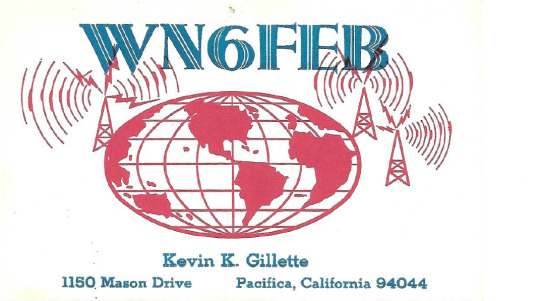
My Extra class license QSL card:
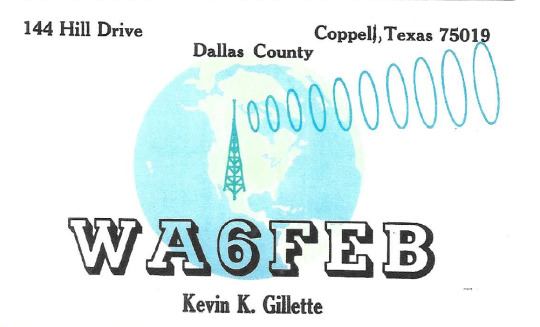
QSL cards are like postcards for hams – we often exchange them to acknowledge that we’ve made contact. They’re often attractive and make great wallpaper or collectibles. I’ve amassed quite a few over the years – there are examples of QSL cards received from around the world at the bottom of this article.
Dovetailing with a previous paragraph, a few words about ham radio frequency bands. Per international agreement, ham radio operators have a large number of radio spectrum segments allocated for their use. It should be noted that in many cases, these allocations are not exclusively for ham radio. One example is the 40-meter band, which covers 7.0 – 7.3 MHz. At least in the 1970s and 1980s, this band featured a lot of non-ham activity, including over-the-horizon radar from the USSR and Voice of America broadcasts from various parts of the world. What made this especially annoying is that the 40-meter band was almost universally open, meaning that effective communication could happen on that band at any time of the day or night, year-round. The Soviet radar sounded like a very loud metronome, and Voice of America was an AM transmission in a segment of the radio spectrum where people didn’t normally use AM, meaning that receivers tuned to this part of the spectrum ended up hearing the carrier as well as the audio signal (which made the audio portion hard to understand). Still, for a young ham radio aficionado hunting for exotic call signs in the ether, it was a lot of fun to wade among the incoherent mass of radio transmissions.
The bands are usually referred to by their approximate wavelength. Recalling that light travels at approximately 300,000,00 meters/second, here is a sample of some of the bands that were popular when I first started back in 1974 (there have been additional bands added to the spectrum since that time; I have no experience on those bands):
HF:
160 meters – 1.8 – 2.0 MHz (I didn’t have any contacts on this band, but my older receiver permitted me to listen in. The antenna requirements for this band are too large for the real estate I had.)
80 meters – 3.5 – 4.0 MHz
40 meters – 7.0 – 7.3 MHz
20 meters – 14.0 – 14.35 MHz
15 meters – 21.0 – 21.45 MHz
10 meters – 28.0 – 29.7 MHz
VHF:
6 meters – 50.0 – 54.0 MHz (note that this is just below the start of the standard television broadcast segment, Channel 2, as noted earlier)
2 meters – 144.0 – 148.0 MHz
I also mentioned the idea of a band being open. On the HF (High Frequency) bands, the propagation of a signal often proceeds in two ways: ground wave and sky wave. Ground wave is exactly as the name implies; the radio signal follows the ground. This signal is of comparatively short distance, perhaps 100 miles or thereabouts. Sky wave is quite a different phenomenon and involves the signal bouncing off of the ionosphere, a layer of our atmosphere that lives between 50 and 600 miles above the Earth’s surface. As the name suggests, this layer contains a lot of ionized particles - mostly from the Sun’s interaction - and it is this layer of ions that forms a sort of reflecting barrier for radio waves below a certain frequency. The highest frequency for which the ionosphere is a reflecting barrier is referred to as the MUF - Maximum Usable Frequency. Above this frequency, radio transmissions pass through the ionosphere and out into space. When a band is open, that means that the MUF is greater than the band’s frequency, at least as an approximation. The 40-meter band is virtually always below the MUF, meaning that it’s open all of the time. This is what makes it so popular. The 20-meter band is often (though not always) open, which is what makes it a premium band for long distance communications, referred to in ham radio parlance as DX (which stands for distance). The 20-meter band has the advantage that it is strictly for ham radio – no competing services cause interference and noise. When an HF band is open, the sky wave mode of signal propagation is also referred to as skip, meaning that the signal will skip off of the ionosphere, sometimes multiple times – this makes for worldwide transmission and reception.
You may be asking yourself what was in it for me, that I would have such fervor for a hobby that is admittedly declining in popularity (with the advent of email and the Internet). I think a simple anecdote will make it clear:
When I was about 15 years old, early in my ham radio career, I lived in a small town near San Francisco and also near Stanford University. I had an on-air friend named David Gray, WB6ZMJ, who was a graduate student in geophysics at Stanford. David was a member of the Stanford Amateur Radio Club (SARC):
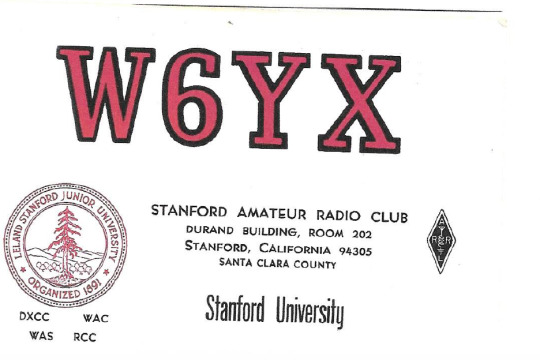
One weekend he invited me down to Stanford to participate in what is known as moonbounce. In moonbounce, hams from across the globe will transmit on the VHF frequencies directly up to the Moon, bouncing their signal off the Moon to be received somewhere else on the planet. Recall what I mentioned above about the MUF; the VHF frequencies are all well above the MUF, so VHF signals cannot participate in the skip mode of propagation (except under some very unusual circumstances). Stanford University has an enormous radio telescope, affectionately referred to as The Dish, that sits on a small hill on the SW side of campus. A picture of it appears below. The Dish is about 150 feet across and was built in 1961. It remains in use to this day. The SARC used The Dish as their antenna for moonbounce activity.

Here's the rub: The path length from Earth – Moon – Earth (EME) is about 500,000 miles. The loss in signal strength approaches 250 dB, which equates to dropping from a Formula 1 roar down to the tiniest of whispers. In fact, the signal strength is so low that even when using CW, the signal isn’t strong enough to trigger a BFO for a sidetone in order to read the signal. The only way to hear the signal is to listen for quiet spots in the background noise! That’s where I came in on this particular occasion. I have (and have always had) exceptionally acute high-frequency hearing, and so what sounded like white noise to the grad students in the SARC was an intelligible signal to me. So, in the middle of the night, there I was, in the metal housing seen at the base of The Dish, listening to a mysterious CW signal from a ham in Sweden coming by way of deep space, and writing down what I heard. For a lonely, nerdy kid, this was the height of affirmation – it was OK to be nerdy and science-oriented when you got to play with such exotic toys! Indeed, not only did this experience cement my desire to pursue ham radio; it also confirmed that Stanford was the place I wanted to pursue my university studies (as indeed I did, graduating with a Bachelor’s degree in applied mathematics and a Master’s degree in operations research, all before my 21st birthday).
In the years following graduation from Stanford, I got married and moved to Dallas, Texas, where once we purchased our first home, I immediately set up a nice ham shack in the laundry room. I made tons of great contacts all over the world with the most modest of equipment (alas, I don’t have any photos of my gear from those days). When we started our family, the hobby had to take a back seat, and eventually I let my license lapse. But now that I am approaching retirement age, I long once more to get back on the air and hunt for those mysterious signals beaming in from everywhere.
Kevin Gillette, 26 January 2024
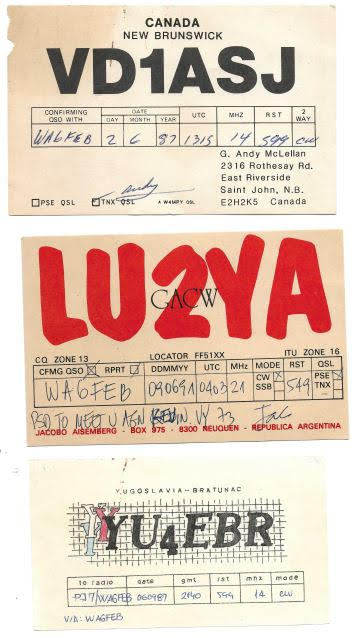
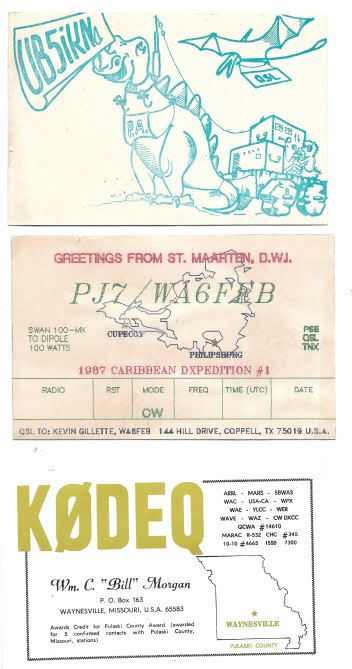



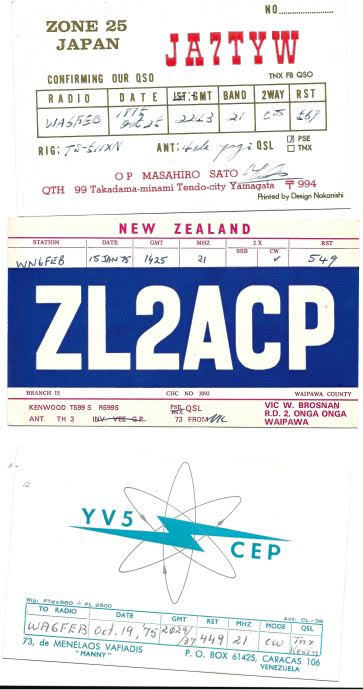

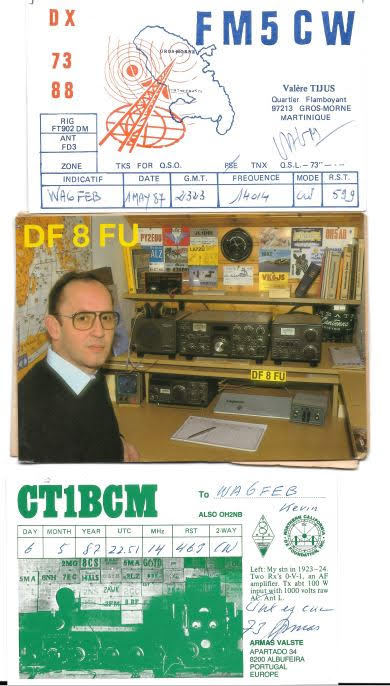

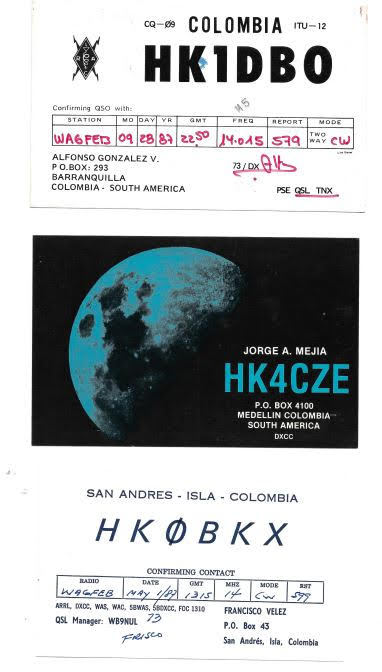
Image credits : Images in the text with thanks to © respective creators and publishers. QSL Cards at end of article above received by author, with thanks to © respective creators
Kevin Gillette
Words Across Time
26 January 2024
wordsacrosstime
#Words Across Time#Kevin Gillette#wordsacrosstime#January 2024#Amateur Radio#Ham Radio#Broadcast Bands#Electromagnetic Field#Stanford Amateur Radio Club#Beat Frequency Oscillator#US Navy#Morse Code#SSB#AM#FM#Maximum Usable Frequency#Sidetone#Sidebands#Continuous Wave#Antenna#Spark Gap#Hobby#Tinkerers#Inventors#Telecommunications#VHF#Frequency Modulation#Amplitude Modulation#Alternating Current#Direct Current
0 notes
Text
Bad Actors
[Bad Actors, by Mick Herron. 10 May 2022. Publisher - Soho Crime. 360 pages. ISBN-10: 1641293373. ISBN-13 - 978-1641293372. Weight - 1.18 pounds. Dimensions : 5.75 x 1.17 x 8.52 inches. (publishing details thanks to Soho Crime)]
In 2010, writer Mick Herron published the first of his 8-book series centered on Slough House, an MI5 property that houses the discarded refuse of the British intelligence apparatus. The slow horses (a play on the name of the facility) are embittered, disillusioned, and disgraced, but evidently not quite to the level of termination. Instead, they labor on pointless, soul-crushing assignments for the Mother Ship of MI5, located at Regent’s Park in London (and prosaically dubbed The Park).
Heading up the slow horses is Jackson Lamb, himself a disgraced and hyper-cynical spy who, for reasons that are never made entirely clear, relishes his command position in this Purgatory of the intelligence community. Lamb is ugly, foul-mouthed, misogynistic, anti-social in the extreme, and has repulsive personal and professional hygiene. He claims to have total disregard (or possibly no regard whatsoever) for the people in his charge, whom he refers to as his joes. But underneath the crass and off-putting demeanor lies a profound and singular intellect and an exceptionally keen understanding of the ways of the world, especially that part of the world dominated by intrigue, deception, treachery and violence. And though he would never, ever admit it, he actually cares about his joes. If anything is to happen to them, it had better be by his hand, or woe be unto the person or persons who got in the way.
The volume under review here, Bad Actors, is the eighth and final (?) book in the Slow Horses series. In addition to Jackson Lamb, many of the usual suspects remain from the preceding seven installments: Diana Taverner, the ruthless and rapacious First Desk at MI5; Roddy Ho, Slough House’s tech genius, a legend in his own mind only; Claude Whelan, who used to head up MI5; Catherine Standish, Lamb’s gal Friday and the bulwark standing between him and the chaos beneath him; and many more.
In this episode, a Downing Street superforecaster – someone who can predict, with startling accuracy, how policies will influence the electorate and advises the Prime Minister on same – has disappeared. Claude Whelan has been assigned the job of finding her. The trail leads back to The Park and Diana Taverner. Just what is she up to? Are her labyrinthine schemes for control of the Intelligence Service coming to a boil? Or is something else at work? Simultaneous to this domestic intrigue is the sudden arrival of Taverner’s opposite number in the Russian intelligence machine, who enters Britain under a false name and promptly loses his MI5 handlers.
Amid the tumult, the Slow Horses become involved in these machinations, for two reasons: One, because they are terminally bored and eager to do something to set their personal records straight and perhaps – just perhaps – inveigle their way back into The Park, even though the history of Slough House suggests that this cannot happen; and Two, because Jackson Lamb hates Diana Taverner and The Park and loves to poke the hornet’s nest whenever and however he can.
Throughout this and the other seven Slough House novels, Mick Herron seamlessly interweaves caustic rhetoric with surprisingly poignant moments. He plays off the Slow Horses against one another to varying degrees while Jackson Lamb lurks like a spider in his darkened corner of proceedings. But when Lamb strikes, they all know to get out of his way (well, all but Roddy Ho who can’t seem to get out of his own way, much less anyone else’s) and let him do what he does best – whatever that is. Lamb, both figuratively and literally, knows where the bodies are buried, and knows this not only within his own agency but with other intelligence services around the globe – including the Moscow directorate. And though Slough House will never get their contributions acknowledged, even Lamb knows that sometimes the only solution to a sticky situation is a few Slow Horses – his joes.
Unlike many of his peers, Herron brings a decidedly literary quality to his writing. Fans of John le Carré will find these novels great fun; they certainly move ahead more swiftly than, say, his Tinker Tailor Soldier Spy or Len Deighton's Funeral In Berlin. There is a modern sensibility to these novels that will catch the interest of most readers of spy fiction and thrillers. And if one can ignore Jackson Lamb’s foulness, one will be rewarding with some of the most sardonic humor to be found in modern fiction. Herron’s writing pairs nicely with a chewy red wine and some spicy crisps of an evening.


Image credits from top : Cover with thanks to © publisher. Portrait of Mick Herron with thanks to photographer © Mikael Buck and Hachette
Kevin Gillette
Words Across Time
19 January 2024
wordsacrosstime
#Mick Herron#Kevin Gillette#Words Across Time#wordsacrosstime#January 2024#Bad Actors#Slough House#British Intelligence#MI5#Slow Horses#Regent's Park#The Park#Jackson Lamb#intrigue#deception#treachery#violence#Diana Taverner#Roddy Ho#Claude Whelan#Catherine Standish#Superforecaster#Downing Street#Prime Minister#Russian Intelligence#John le Carré#Len Deighton#Tinker Tailor Soldier Spy#Funeral In Berlin#chewy red wine
2 notes
·
View notes
Text
Limit Distributions for Sums of Independent Random Variables
[Limit Distributions for Sums of Independent Random Variables, by BV Gnedenko (Author), AN Kolmogorov (Author), KL Chung (Translator). Paperback (Reprint of the 1954 Edition) - 5 Aug 2021. Publisher - Martino Fine Books (5 Aug 2021). Language - English. Paperback - 276 pages. ISBN-10 - 1684225795. ISBN-13 - 978-1684225798. Dimensions - 15.6 x 1.57 x 23.39 cm. (details thanks to Amazon)]
[Author full names: Boris Vladimirovich Gnedenko (Russian: Бори́с Влади́мирович Гнеде́нко; 1 January 1912 – 27 December 1995); Andrey Nikolaevich Kolmogorov (Russian: Андре́й Никола́евич Колмого́ров, IPA: [ɐnˈdrʲej nʲɪkɐˈlajɪvʲɪtɕ kəlmɐˈɡorəf], 25 April 1903 – 20 October 1987) (details thanks to Wikipedia)]
***
A number of years ago I set about a course of self-improvement. For me that meant reading as much as possible from works written by world-class thinkers. This list of august minds was often, though not solely, driven by Nobel Prize winners and other winners of similar or equivalent awards in other areas (mathematics, for example, where the Fields Medal and Abel Prize are the highest honors). However, I am a statistician among other things, and so I have also kept a keen eye out for important works by the giants of that field.
I am not well-acquainted with Boris Gnedenko, though his name has certainly come up from time to time over the years that I’ve both studied and practiced statistics. The name that has come up repeatedly in reverential tones is Andrey Kolmogorov, who is one of a handful of mathematicians who are credited with giving the theoretical underpinnings of statistics a solid and rigorous mathematical foundation.
The volume under review here is one of Kolmogorov’s most important publications. In it, he and Gnedenko elicit the basis and application of results like the Central Limit Theorem (CLT) and the Law of Large Numbers (LLN). These are two of the most important results in all of statistics and probability theory and the slightly more general theory of stochastic (random) processes.
I should mention that this volume was originally published in the Soviet Union in 1949 in Russian. The edition I read here was translated into English in 1954 by KL Chung, and the actual ISBN citation is this particular reprint; there are others from different time periods, and of course if one is a true purist, then one should definitely read the original Russian text. However, according to the preface, all of the formulas and other special figures in the text are actually photostats from the original monograph.
I really enjoyed this book. The writing style of Gnedenko and Kolmogorov is delightfully lofty and at times quite flowery, but their explanations of proofs and motivations for results are really first-rate. I wasn’t sure what to expect, given the high intellectual bar these gentlemen set, but I was very pleasantly surprised. Professor Chung, the translator, added quite a few helpful comments and clarifications where appropriate, but overall he seems to have let the book flow as it was originally set down. One of the Appendices was written by another legendary statistician, JL Doob, providing a bit of bridge material related to some measure-theoretic issues that arise in Chapter 1.
My only complaint (a very small one to be sure) is that there were a number of typos that remained intact despite the extensive editorial review this monograph has surely had over the past 70+ years. I wouldn’t exactly call it a super-power, but I personally seem to have a knack for finding typos and grammatical errors in even very technical material. I’ve taken photos of two of the ones I found early in the text as examples here (see below). For some reason my eye was instinctively drawn to these and others. I would thus advise the reader to pause if something seems slightly amiss – it very well might be. I’m happy to say that these errata were few and far between, and in no case do I recall them rendering the explanations or results indecipherable.
Who would enjoy this tome? Anyone who is interested in the theoretical basis for many of the classic results in modern non-Bayesian statistics. The foreword by the translator advises that a solid background in calculus is a must, and mathematical maturity a definite plus. Beyond that, the book itself is remarkably self-contained. This is likely due to the political environment in which it was written. Post-World War II was a difficult time for Soviet intellectuals since they were generally denied access to journals and results outside their own country.
Here are the two examples of typos that I detected early in the book – I think they speak for themselves, but you can be the judge:
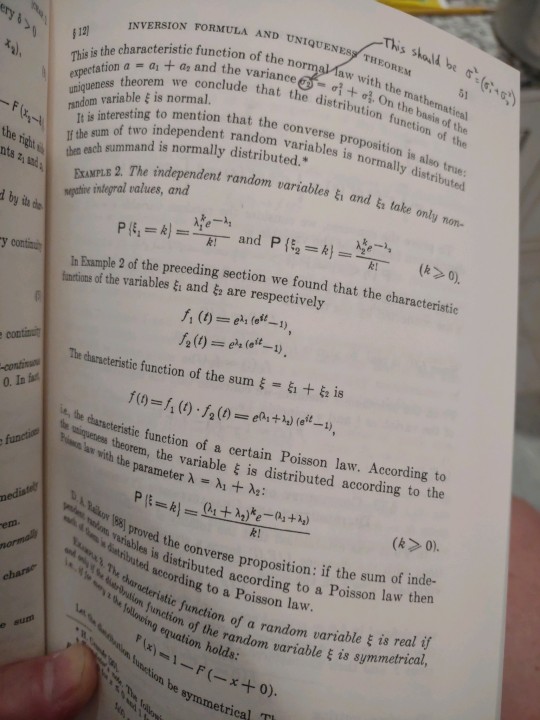
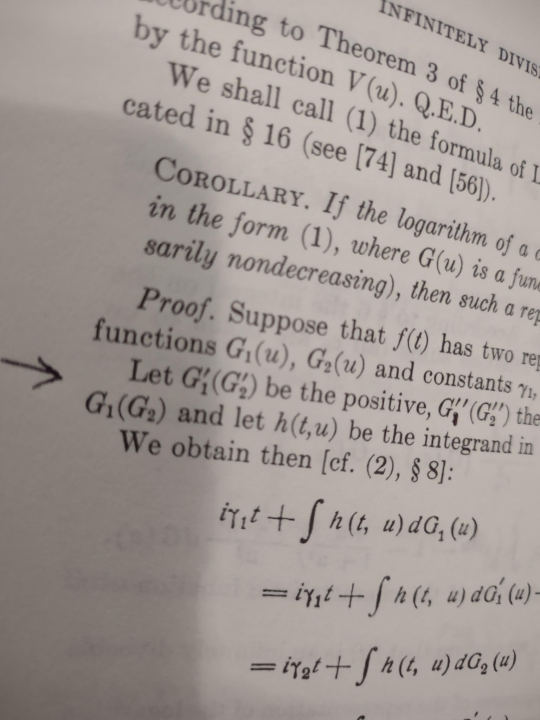
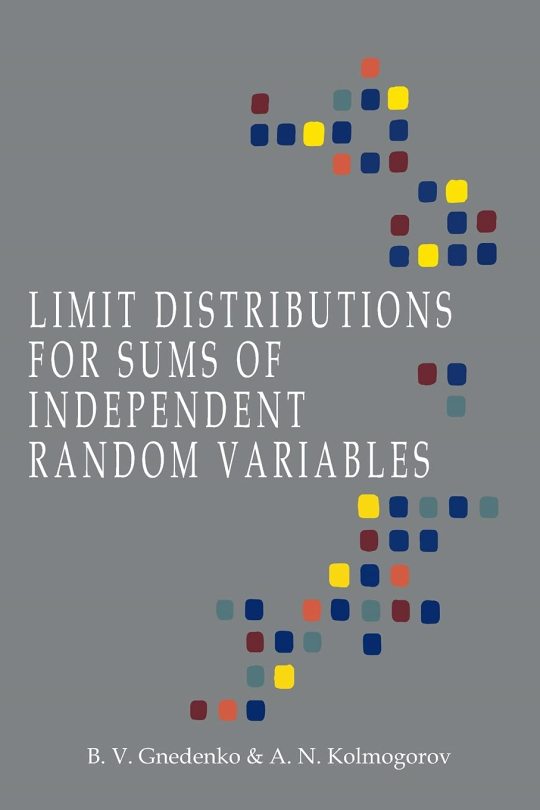

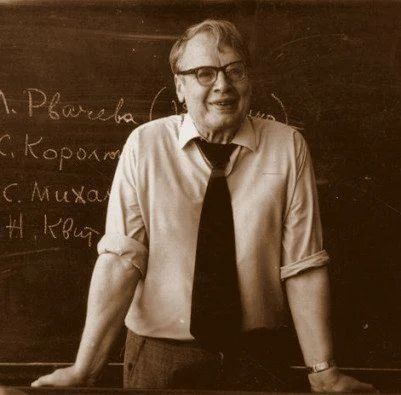
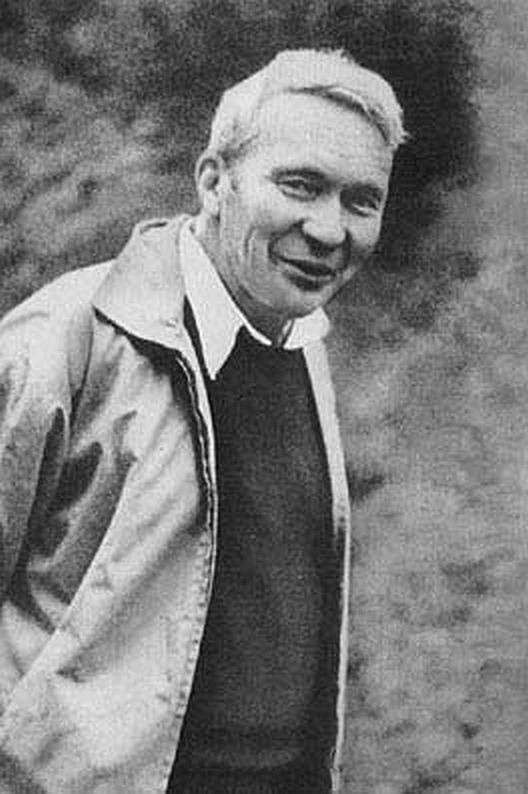
[Image credits numbered from top: (1 & 2) two pages from the book photographed by reviewer- with thanks to © publishers and estates of authors. (3 & 4) book cover front and back - with thanks to © publishers (5) Boris Vladimirovich Gnedenko - with thanks, no details of © copyright holder / photographer known (6) Andrey Nikolaevich Kolmogorov - with thanks, no details of © copyright holder / photographer known]
Kevin Gillette
Words Across Time
12 January 2024
wordsacrosstime
#kevin gillette#January 2024#wordsacrosstime#words across time#Martino Fine Books#Boris Vladimirovich Gnedenko#Бори́с Влади́мирович Гнеде́нко#Boris Gnedenko#Andrey Nikolaevich Kolmogorov#Андре́й Никола́евич Колмого́ров#Andrey Kolmogorov#Andrei Nikolaevich Kolmogorov#Andrei Kolmogorov#Fields Medal#Abel Prize#Statistics#Central Limit Theorem#CLT#LLN#Law of Large Numbers#Stochastic#Probability Theory#KL Chung#Soviet Union#WW2#JL Doob#Typos#Tome#Non-Bayesian statistics#Soviet Intellectuals
0 notes
Text
Language
[Language. Journal of the Linguistic Society of America. 2023. ISSN 0097-8507. With reference in part of this overall review to two articles from Volume 99, Number 2, June 2023]
Readers of my many book reviews will have noted that among my intellectual pursuits lies a fascination with all things related to language and linguistics. I took a glance at my running list of reviews to date: not including this review, I have essayed 13 books in the linguistic field (out of 59 in total). As I approach retirement age, I am seriously contemplating pursuing a PhD in linguistics. With that in mind, I finally took the plunge and joined the Linguistic Society of America (LSA), one of the largest, oldest and most well-respected academic peer groups in the linguistic arena.
Linguistics, like so many fields of endeavor, has numerous components to it. To excel in it, one must generally specialize. Assuming that I follow through on my threat/promise to pursue a graduate degree in this field, I will probably focus on one or more of three areas: native languages of North America, language preservation and revitalization, or forensic linguistics. Membership in the LSA gives me a somewhat broader window into these and all other sub-fields within linguistics.
A capstone of membership in LSA is a subscription to the quarterly journal Language. This is a peer-reviewed journal that serves as the official organ of the LSA. To my delight, it turns out that not only do I receive the quarterly journal in the mail, but as an LSA member I also have unfettered access to all prior editions of the journal online. I have been spending some guilty pleasure time rummaging through past issues, looking not only for nuggets in the form of articles, but also for references to books and monographs that might quench my thirst for knowledge.
This is a pretty weighty journal, which I prefer. I do so love a challenge. And since I have no formal training in linguistics, I must concentrate rather harder than a specialist might in order to follow what’s being discussed. My reward for these efforts is an ever-increasing degree of interest in the subject.
The current edition that I am poring over is Volume 99, Number 2, published ostensibly in June 2023 (it was actually delayed a few weeks due to a technical issue). So far I have read two of the articles in this edition. I will summarize them for you, as I think they paint a perfect thumbnail sketch of Language as a journal:
The first article talks about subjecthood and syntactic ergativity in West Circassian (also known as West Cherkessian or Adyghe), a Northwest Caucasian language. I admit that I was puzzled about the idea of subjecthood even being a question. After all, in English, the subject of a sentence is usually fairly unambiguous. However, this is a simplistic perspective on language – there’s no reason that the subject of a sentence needs to be obvious at all, at least not to someone who is not a native speaker. In most entries in Wikipedia on languages there is a section for the grammar of the language that will identify them as being something like a SVO (Subject Verb Object) language (like English), or perhaps a SOV (Subject Object Verb) language (like Turkish). All 6 possible permutations of these positional identifiers occur in at least one known language spoken on Earth, although some are far more common than others – for example, VOS is almost unknown, whereas SOV and SVO are both quite common. However, if one looks at the entry for Adyghe (Adyghe language - Wikipedia) under the Grammar section, one notices that the grammar is described as AOV (Agent Verb Object) The word Subject, which has a strong typological connotation in English, has been replaced by Agent, which is a more abstract concept. As the word implies, the Agent in a sentence in Adyghe is the causative element that drives the sentential narrative, but it is a fuzzier distinction than the notion of a Subject in English. Moreover, the phrase syntactic ergativity alludes to a notionally morphological concept called ergativity which alludes to an action perpetrated by some element of the sentence (the word ergative derives from the Greek word ergos, meaning work). Morphological ergativity is usually expressed with some sort of suffix (common), prefix (uncommon), or infix (very uncommon) applied to a noun or noun phrase in the sentence. This is true, for example, in languages like Basque, Pashto and Urdu. In Adyghe, the ergativity of the Agent in the sentence is expressed more indirectly, eg by the position of the Agent within the sentence. This feature is so rare that there is only one other language reported to have it – Dyirbal, spoken in Queensland, Australia.
The second article discusses the notion of plural formation in Maltese. Maltese is a Semitic language, most closely related to Arabic but containing significant substrata derived from Italic languages (notably Italian and Sicilian), and more recently, English. It is also the answer to a fun trivia question: What is the only Semitic language written in the Latin script and read left-to-right? Like most languages, Maltese has a number of different strategies for forming the plural of nouns. Indeed, the authors of the article enumerate no fewer than 24 separate rules for making plural or dual nouns out of singular noun forms. These rules are broadly split into two categories: those that exhibit regular suffixation (sometimes modifying the final letter in the word to promote ease in pronunciation and comprehension) and those that exhibit split plurality where the change in word form is less linear. English has these sorts of plurals as well: man -> men, woman -> women, mouse -> mice, goose -> geese, etc. The main thrust of the article is to develop what is called a generative model of Maltese plural production that can take any Maltese noun and correctly create – that is, predict – the plural form. The authors subjected a large corpus of Maltese noun forms to several computational linguistic models to try and come up with the best protocol for modeling the generation of plural forms.
I hope that gives you, the reader, a good idea of what Language is all about. If you are a budding linguist or even a practicing one, you will find this journal a fountain of information. I recommend Language to any linguistics student, scholar, or arm-chair dilletante such as myself (for now).

[Image credit with thanks to : © Linguistic Society of America]
Kevin Gillette
Words Across Time
25 August 2023
wordsacrosstime
#Kevin Gillette#Words Across Time#wordsacrosstime#August 2023#Language#Linguistic Society of America#Linguistics#Peer Group#Native Languages North America#Language Preservation#Language Revitalization#Language Revitalisation#Monographs#Subjecthood#West Circassian#Adyghe#English#Turkish#Subject Object Verb#Agent Verb Object#Syntactic Ergativity#Morphological#Infix#Dyirbal#Queensland Australia#Maltese#Plural Formation#Semitic Language#Suffixation#Split Plurality
0 notes
Text
Bookshop - Any Amount of Books, London
[Any Amount of Books, 56 Charing Cross Road, London, WC2H 0QA]
Any Amount of Books [AAOB] in the centre of London (local tube station Leicester Square) is a bookshop selling secondhand books.
It's well-known for the green boxes of books outside, at £1.50 each. Inside are two floors of - very literally - wall-to-wall books, across pretty much every category one can think of.
An earlier article about the shop at https://wordacrosstime.tumblr.com/post/152692234989/bookshop-any-amount-of-books-london describes it more fully. Not much has changed in the range of books, but the interior has been entirely re-done to create more space for customers to move around and to get more easily to books. Like many secondhand bookshops, people like to be able to spend time finding what they want, and it's a friendly place with no-one pressing to sell books and hurry people along.
AAOB says it wants to provide a wide range of secondhand books that meet 'the kind of needs people don't know they have', with a general direction - but not exclusively - of 'the humanities'. Books are 'reasonably priced' with the aim of being 'the best-priced bookshop in London, with something for almost everyone'.


[Images: with thanks to the copyright holder/s]
John Park
Words Across Time
20 June 2023
wordsacrosstime
#Any Amount of Books#Words Across Time#wordsacrosstime#June 2023#John Park#Bookshop#Secondhand Books#Literary Fiction#Decorative Books#Novels#Historical Novels#Antiquarian Books#Dime Novels#Books#Charing Cross Road#Leicester Square#Soho#Chinatown#Bryan Forbes#Christopher Lee#Film Shoot#Film Set#TV Stage Design#Stage Set#Interior Design#Leather-Bound#Rex Warner#The Aerodrome#Frank Harris
0 notes
Text
A Diamond In The Dust
["A Diamond in the Dust - The Stuarts: Love, Art, War" by Michael Dean. 24 November 2022. Holland Park Press Ltd. Paperback. 225 pages. ISBN: 9781907320965]
The brutal murder of King Charles I was followed by the establishment of the Commonwealth of England, a brief republic. Reinstatement of the monarchy with his son Charles ll was accompanied by the execution of the judges - the Regicide Judges - who had condemned Charles I to death. Ten of them were hanged, nine of whom were hanged, drawn and quartered. The ringmaster Oliver Cromwell died naturally. His corpse was exhumed, hanged at Tyburn (in London, now Marble Arch), beheaded, and its head mounted above the building where Charles I had been tried.
They knew how to do things in those days.
Michael Dean's A Diamond in the Dust starts and ends with the show trial and execution of Charles I, with a second book - The King's Art - scheduled to take the story forward.
Shortly before his death, Charles I wrote a (very long and frankly dreadful, but yes, execution was going too far) poem titled (with capitals as written) Majesty in Misery, Or an Imploration to the KING OF KINGS. It's not known if God has read it yet, it could take a while. Mercifully Michael Dean only quotes three lines and then solely to explain the title of the book:
With my own Power my Majesty they wound,
In the King's name the King himself's uncrown'd,
So doth the dust destroy the Diamond.
Watch those capitals Charles. Upper Class OK, Upper Case seldom.
Michael Dean's delightful A Diamond In The Dust is a very exact account of many of the painters artists soldiers and male prostitutes who flourished around the courts of Europe. Charles emerges as worried about what he felt was his mis-shapen body until he finds he is good at something. That something, in what was perhaps his own language was f__king. And to give it context, music, sculpture, f__king, religious wars, wars, f__king, spending money he didn't have, f__king, and when at a loss for something to while away his sybaritic hours, not-surprisingly, more f__king.
This should not suggest that Charles I was promiscuous. On the contrary he and his wife Henrietta Maria seem, after a difficult start (there was a lot of religion, catholic and protestant, involved - all across Europe and all across their lives) to have been not simply in love, but profoundly in love. Charles I does emerge at times as a bit of a pr__k, but, as the English public of the time might well have said, 'at least he's our pr__k).
Art, politics, religion, shipwrecks. Michael Dean knows his controversies and A Diamond In The Dust is crammed to the gunwales with them. George Villiers, 1st Duke of Buckingham is a superbly-drawn (he's real - all the people in the book are, and there are tons of them) character, sexually versatile on both sides, bold, generally courageous, a kind of World-War-II-We'll-Fight-Them-On-The-Beaches lad (he might well have turned up there for a cameo), hated, unfortunately by Queen Henrietta, and in the end murdered. The narrative does slump a bit when he exits, but it's coming to the end (for Charles I) when he leaves the story, and Charles is only going one way.
Michael Dean is expert with history and characters. His novel about the painter Marc Chagall, The White Crucifixion (2018) as well as being a fine novel is a smart piece of work, coming across - like A Diamond in the Dust - with the feel of historical accuracy (only God knows if it's extremely true, but He's tied up with Charles I's Majesty in Misery, possibly for eternity).
A Diamond in the Dust may be one for (1) history experts who long to pick holes in other historians' work while gloating at their superiority; (2) fanatical puritans (OK, Americans), protestants, catholics (it's got lots of all of them, entangled, not always religiously) (3) Republicans (4) Royalists (5) fans of art (yards and yards of art in 225 pages, lots of named works, very detailed biographies of big (and interestingly obscure) artists and patrons. And others who hate being categorised but read The Guardian flagrantly, with a fixed expression of disapproval.

[Image credit: book cover, with thanks to the copyright holders]
John Park
Words Across Time
19 May 2023
wordsacrosstime
#A Diamond In The Dust#Michael Dean#John Park#Words Across Time#wordsacrosstime#May 2023#Holland Park Press#The Stuarts#Bernadette Jansen op de Haar#History#English History#Charles I#Charles II#George Villiers#Duke of Buckingham#Henry Wardlaw#Frances Howard#Queen Henrietta#Anthony van Dyck#Hubert Le Sueur#Oliver Cromwell#Nicholas Lanier#Endymion Porter#Wat Montagu#Abraham van der Doort#Peter Paul Rubens#Jan van Belcamp#Sir John Suckling#Privy Gallery#Henry Frederick
4 notes
·
View notes
Text
Practical RF Design Manual
[Practical RF Design Manual by Doug DeMaw (Milton F "Doug" DeMaw). 1997. MFJ Publishing. 2nd Edition 1997 : 246 pages. ISBN 1-891237-00-4]
For many years I was an amateur radio - "ham radio" - operator, beginning when I was 13 years old and going up until I was about 40 years old. For those who are interested, my call sign was WA6FEB and I held an Extra Class ham radio license (this is the highest classification). My fascination with radio was fostered by my step-father, the late Sam Martin (WB6WZN, later N7TBV), who had learned his electronics and radio theory while serving in the US Navy.
Sam had many years’ worth of a magazine called QST, which was one of the premier journals available for ham radio enthusiasts. Doug DeMaw, the author of the book under review here, was a prolific contributor to QST and to other ham radio publications. I was (and remain) a huge fan of his writings, especially his transmitter and receiver projects for ham radio folks.
What I did not know then, but have come to learn, is that DeMaw was truly a world-class electrical and electronic engineer. He was known to much of the world as a ham radio person first and foremost, but he was a professional engineer who had an extraordinarily broad grasp of all aspects of radio transmission and reception, covering all power levels from the very tiny (what we in the ham radio community called QRP, or low-power, operation, usually less than 1 watt) to the industrial (the 50,000-watt and 100,000-watt “clear channel” broadcasts from commercial radio stations, for example). DeMaw was well-versed in design considerations spanning operating frequencies from the US AM broadcast band (560 KHz to 1600 KHz) all the way up to the UHF range (where television broadcast channel 14 begins in the US, or around 470 MHz and beyond). His knowledge went beyond component-level design of devices to include the design and tuning of antennas and other auxiliary devices to aid in the radio experience.
All of this knowledge is subsumed under the aegis of RF - radio frequency. RF in modern terms is usually linked to RF ID chips, which are becoming quite common in scenarios that require tracking (such as shipment packages), but this is a very restricted window into the RF world. To really see just how vast an enterprise RF electronics is, one might consult this book.
This volume is truly a gem. I dearly wish I had access to it back in the early 1970s when I was first getting into radio. It would have illuminated a lot of practical design issues for me, especially on the design of receivers. Receivers are generally more complicated and finicky than transmitters – it’s easier to generate radio energy and cast it out into the universe than it is to gather it in and make sense of it. This book leads the reader through 7 broad-based topics and roughly 40 overall subsections within those topics, starting with transmitter and receiver fundamentals and leading the reader through considerations related to power regulation, signal quality, the use of different types of components for different frequencies of operation and different power levels, and so on.
Unlike much of DeMaw’s writing with which I had been previously acquainted, this book is definitely not a book for someone looking to do a home project. There are no comprehensive instructions on assembling or testing transmitters, receivers, or other associated machinery. This book is written for a true engineer who wants to become familiar with many (most) of the gotchas that accompany real in-the-trenches electronic engineering work. And in this vein, this book is as useful to a professional radio engineer (such as someone who is the engineer-in-charge at a radio or television station, for instance) as it is to a radio hobbyist. It is also not the sort of book from which to learn first principles of electronics; for this, there are many more suitable books that introduce electronics at the most elementary level (Ohm’s Law, Kirchhoff’s Law, how vacuum tubes and transistors work, what makes oscillators work, and so on). This book assumes that the reader already has some engineering skin in the game, as the saying goes.
Whom would I recommend this book to? Anyone who wishes to know something about electronics that precedes the modern all-digital era where whole systems are embedded on integrated circuit (IC) chips. While those circuits may make for easier and more controlled design, they take away a lot of the learning, guesswork, and outright fun of figuring these things out for yourself. DeMaw’s work hearkens back to what many of us current and former ham radio people think of as a sort of golden era of communications – a time before cell phones and before email.
A couple of comments about the text itself:
There are some typos both in the text and on the many diagrams. For the most part these are easy to spot if you are already versed in basic electronics, but they would be profoundly confusing to someone who doesn’t know what they’re looking at. Anyone who doesn’t know how to read a basic schematic diagram of a circuit will not find this volume very helpful.
Bearing in mind that some of the material in this book dates to the 1970s and 1980s, it is possible that some of the actual components cited in the text no longer exist or are not easily available. Happily, the author describes them in sufficient detail that a modern engineer or hobbyist can find current components whose characteristics match what DeMaw had at his disposal when the book was written. DeMaw was fairly fastidious about describing the important pieces of each circuit or circuit fragment in the book. One needs but to pay attention to the text to make the connection.
I was delighted to read through this volume. I am not currently an active hobbyist, but as I near retirement age, I am giving a return to ham radio serious thought. With that in mind, this book will be an invaluable title in my collection when I once again wield a soldering iron and set out to make some more home-brew radio equipment as I did so many years ago.


[Photo credits with thanks to : Book Cover of 2nd edition 1 August 1997 © 1997 M F J Enterprises Inc / Portrait © Copyright Holder (apologies not known)]
Kevin Gillette
Words Across Time
10 January 2023
wordsacrosstime
#Kevin Gillette#Words Across Time#wordsacrosstime#Practical RF Design Manual#Doug DeMaw#January 2023#Ham radio#US Navy#QST#Transmitter#QRP#Antenna#Radio Frequency#Power Regulation#Signal Quality#Electronic Engineering#Television Station#Radio Hobbyist#Ohm’s Law#Kirchhoff’s Law#Vacuum Tube#Transistor#Oscillator#Receiver#Sam Martin#Amateur Radio
6 notes
·
View notes
Text
Ingush Grammar
[Ingush Grammar. Johanna Nichols. First Edition: March 2011. University of California Press. Series: UC Publications in Linguistics. Pages: 830. Trim Size: 7 x 10 inches. Illustrations: 1 map. Paperback. ISBN: 9780520098770]
Readers of my book reviews cannot help but notice my interest in – nay, my fascination with – linguistics and languages. I am no stranger to Professor Nichols’s work: I read her award-winning treatise Linguistic Diversity in Time and Space a few years ago and was captivated by her command of language reconstruction principles. Recently, it came to my attention that there might (in principle) be a call for persons to assist in national security-related activities who are fluent in, or at least familiar with, the Northeast Caucasian languages, especially Chechen and Dagestani. The language discussed here, Ingush, is a closely-related language with a relatively high degree of mutual intelligibility with Chechen, Dagestani and Baltsi. Since I couldn’t find a suitable book from which to learn Chechen, I thought I’d check this tidy little volume out.
“Tidy” is not the correct word for this work. It tips the scales at almost 800 pages. However, it is an undeniable tour-de-force of scholarship in the documenting of a comparatively obscure language. Prof. Nichols herself acknowledges that this tome is the culmination of about 30 years of work with Ingush, at least ten of which were spent in the homeland of the language itself, a region now known as Ingushetia in southern Russia adjacent to the Republic of Georgia and Chechnya.
The Northeast Caucasian languages are a small primary language family spoken almost exclusively in the region between the Republic of Georgia and the north end of the Caspian Sea. Significant cities in this region are Ongusht (whence the name Ingush), Groznyy (the capital of Chechnya) and Makhachkala (the capital of Dagestan). Though these languages share many features with Georgian (known as Kartuli to its speakers) and the similarly-named Northwest Caucasian languages (examples are Abkhazi and Cherkessian), they are not, in fact, related to them in any meaningful way. This may seem surprising when one looks at a map of the region. The area covered by these three language groups (Georgian is part of its own tiny language family called the Kartulian languages) is fairly small. However, the area is peppered with mountain ranges that have carved it up geographically to a point where very ancient steppe peoples had settled in individual valleys and had no direct contact with even neighboring valleys for centuries. Little wonder, then, that language families developed independently from a still-more-ancient proto-language (as yet unidentified or classified).
Ingush, as alluded to in the previous paragraph, was named after a prominent community in its sprachbund, or speaking area. Ingush people do not use this term, referring to their language as vai mott (our language) or, if speaking to non-Ingush speakers, vai neaxa mott (our people’s language). Given that the homeland for this language has at least three well-defined geographic zones (alpine highlands, piedmont, and plains), it is not surprising that various dialects of Ingush have emerged. All of these dialects are highly mutually intelligible, far from any objective criteria that would categorize them as distinct languages in their own right.
Nichols herself, in the introductory material, lists Ingush as one of the most morphologically complex languages in her experience, outstripping even daunting native American languages like Lakhota (a Siouan language of the northern Great Plains) and Halkomelem (a Salishan language from the Pacific Northwest in the USA). Ingush has unusually large inventories of elements (phonemes, etc.), a high degree of inflectional synthesis in the verb (this is similar to some native American languages, especially the Athapaskan group) and a variety of categories of words, many of which do not have an analogue in English or any Indo-European language. She comments that this might go some way toward explaining why this book took 30 years to produce!
Since the volume is so detailed, I will simply summarize my observations of its style and completeness. I confess that I haven’t actually read the entire volume – I’ve probably read about 150 pages, or nearly 20% of it all told – but I have dipped into it in various places along its length to see what it was all about. It is impossible for me to imagine that Prof Nichols missed anything; every conceivable component of Ingush seems to be covered here. The book has 35 major sections, any one of which is worthy of at least a semester-long course of study (for the subject itself, not necessarily for Ingush per se). Her writing tone and style strike an admirable balance between being very scholarly (it certainly is that) and yet being profoundly informative to a non-specialist like myself who is also not a trained linguist.
The best affirmation I can make of this book is that it is quite possibly the best template for any field linguist to follow when documenting and characterizing a language. This is certainly true for someone working with an Endangered language, of which there are literally thousands still being spoken (some just barely) in the world today. The level of commitment Prof Nichols has brought to bear on this work seems nothing short of miraculous.
This is definitely not a book for just anyone. Like attempting to read all of Proust in the original French while not actually speaking French, a true appreciation of this book requires enormous patience and strong memory skills. Prof Nichols refers to sections back and forth across the book, of necessity since linguistic elements do not exist in a vacuum. That said, to truly appreciate the scope and even grandeur of this volume will command great mental agility and focus. For anyone who is up to the challenge, I say, “Good luck – and enjoy!” Even if you never speak Ingush or travel to that part of the world, this book will teach you something useful, edifying, and mind-expanding.


[Photo credits with thanks to : Book cover © 2011 University of California Press / Portrait © 2012 Wissenschaftskolleg zu Berlin]
Kevin Gillette
Words Across Time
28 September 2022
wordsacrosstime
#Kevin Gillette#Ingush Grammar#Words Across Time#wordsacrosstime#September 2022#University of California Press#Johanna Nichols#Linguistics.#Language Reconstruction#Northeast Caucasian Languages#Chechen#Dagestani#Ingush#Baltsi#Ingushetia#Southern Russia#Republic of Georgia#Chechnya#Caspian Sea#Ongusht#Groznyy#Makhachkala#Dagestan#Kartuli#Northwest Caucasian Languages#Kartulian#vai mott#Lakhota#Siouan#Halkomelem
14 notes
·
View notes
Text
The Weight Of The Vacuum: A Scientific History Of Dark Energy
[The Weight of the Vacuum: A Scientific History of Dark Energy. By: Helge S Kragh, James M Overduin. Ist Edition. Date: 5 June 2014. Publisher: Springer, Berlin, Heidelberg. Series: SpringerBriefs in Physics. Pages: 121. Illustrations: 23 black and white. Dimensions: 15.49 x 0.71 x 23.5 cm. ISBN: 978-3-642-55089-8.(Thanks to publisher for publishing information)]
One of the most surprising and fascinating aspects of astrophysics and cosmology today is the notion of ’dark energy‘ and its evil twin ’dark matter‘. These are not in quotes to suggest that they are somehow fictitious; rather, this is to call them out as significant topics that have dominated much of the current discussion in modern physics dealing with gravity, expansion (or not) of the universe, and other issues that drive humanity’s relentless quest to understand our place in the grand scheme of reality.
It is difficult to appreciate where these issues and questions arise without understanding the sort of thinking that preceded the modern view. This tidy monograph does an outstanding job of filling in those historical blanks, so to speak. Starting with Aristotelean logic from ancient Greece and moving smoothly through the salad days of Isaac Newton into the twentieth century and beyond, this book demonstrates the evolution of natural science (previously referred to as natural philosophy, which might actually be a better choice today!) from pure empiricism to hypotheses borne from mathematical considerations. And lying in wait amid all of these intellectual perambulations is dark energy.
So, what is dark energy? Put simply, no one really knows! In one respect, the existence of dark energy can be seen to follow logically from quantum mechanics (and its smarter younger sibling, quantum field theory) and the famous Uncertainty Principle from Werner Heisenberg. This latter principle states that it is impossible to simultaneously measure both the position and the momentum of an object to arbitrary precision. The idea is that any such measurement of one property inherently perturbs the other – you can’t get something for nothing. However, the Uncertainty Principle has far-reaching implications in related measurements. For example, this means that there is no such thing as a perfect vacuum – the complete absence of any sort of matter (or energy) in a parcel of empty space. That’s because if such a thing were possible, then an observer could state that the parcel of empty space has zero energy and zero mass, ie we know where the parcel is (exactly) and we know what its exact momentum is (zero). The Uncertainty Principle says that this is a no-no. A cartoon may illustrate this more succinctly:
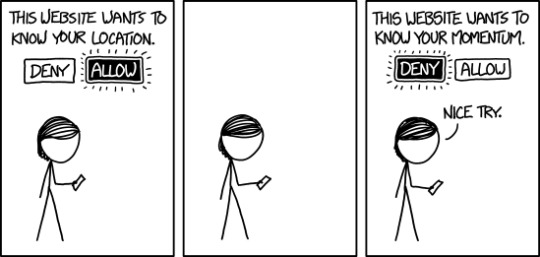
The key is to focus in on the energy element of the previous assertion. In all of the universe, empty space and all, there is something called the zero-point energy. What this means (loosely) is that even empty space ‘contains’ energy. In fact, the energy content of empty space is quite large indeed, although exact computation of its value has proved elusive. But nearly every astrophysicist agrees that this mysterious energy budget accounts for the lion’s share of energy in the universe in total – certainly greater than 50%, and by some estimates, as much as 90% of the universe Actually that’s only partially true; due to Einstein’s famous equation, E = mc2, energy (E) and mass (m) are essentially interchangeable, so lumped in with the energy budget is an implicit mass budget into which the energy can convert under certain conditions.
So what does all of this dark energy (and matter) mean for our understanding of cosmological properties? It’s a mixed bag – on the one hand, one property of dark energy and matter is that they don’t appear to directly interact with ordinary energy and matter (which means we can’t directly observe either one), but on the other hand, they do appear to be driving a large portion of the dynamics we can see through telescopes and other instruments. For instance, dark matter is thought to be integrally involved in the unusual speed of rotation of the outer arms of many (most?) galaxies (although there is a modern theory - called MOND - that might offer a different explanation of this phenomenon without needing dark matter). Similarly, dark energy is thought to explain much of the noted expansion of the universe in all directions, sort of like an explosion into the void.
It’s a highly technical and controversial area of modern physics. This monograph will set the stage for the reader; further research will require delving into the more academic journals and texts to see what’s really going on (or what we think is going on). There are whispers of superluminal (faster-than-light) particle movement, arrow of time reversal, and other exotic ideas all wrapped up with dark energy and dark matter. This book invites the reader to take the next step and check out what this could mean in a larger sense.
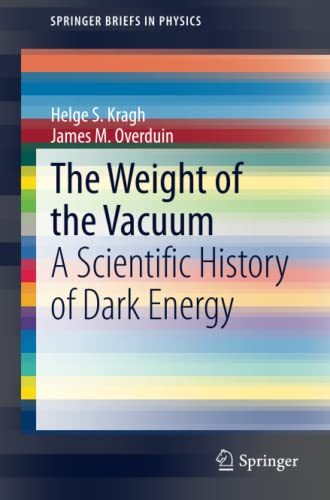

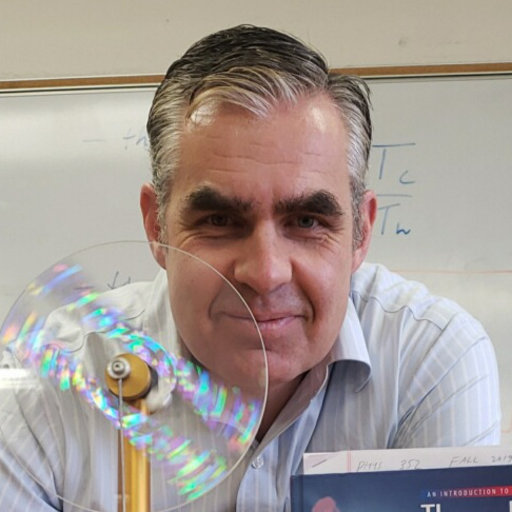
[Photo credits (with thanks to copyright holders) top to bottom: Cartoon: © Copyright holder. Cover: © Springer. Portrait of Helge S Kragh © Copyright holder. Portrait of James M Overduin © Towson University USA]
Kevin Gillette
Words Across Time
9 September 2022
wordsacrosstime
#Kevin Gillette#The Weight Of The Vacuum#Words Across Time#wordsacrosstime#September 2022#Helge Kragh#James Overduin#Springer#Dark Energy#Vacuum#Dark Matter#Towson University#Aarhus University#Cosmological Constant#Cosmological Vacuum Energy#Ether in Physics#History of Cosmology#Inflation in the Early Universe#Variable Physical Constants#Zero-point Energy#Vacuum Energy#Physics#Nernst’s Cosmic Quantum-Ether#Planck’s Second Quantum Theory#Cosmology#Philosophy of Science#Philosophical Foundations of Physics and Astronomy#Aristotle#Isaac Newton#Uncertainty Principle
1 note
·
View note
Text
A Short Course In Computational Geometry And Topology
[A Short Course in Computational Geometry and Topology. Herbert Edelsbrunner. 2014. Publisher: Springer. Book series: SpringerBriefs in Applied Sciences and Technology. Sub series: SpringerBriefs in Mathematical Methods. Pages: IX, 110. Softcover ISBN: 978-3-319-05956-3. Thanks to publisher for publication details]
For many decades the job title statistician was sufficient to describe a practice involving mathematics, computation, and more than a smidgen of artistry and intuition. In today’s complex, extremely fast-paced digital world, this title is no longer sufficient; instead, the terms data scientist and machine learning expert have become pre-eminent. Along with this upgrade in nomenclature has come an explosion in techniques that straddle the admittedly fuzzy boundaries between mathematics, computer science, statistics, and even the physical sciences from which a great many inspirations and innovations are drawn.
One of the most fascinating (at least to this writer) developments over the past 15 years or so has been a subject loosely called TDA, or topological data analysis. Simply put, this technique seeks to locate and recognize patterns within numerical and semi-numerical data that is generally hidden behind a veil of nebulous vantage points and high-dimensional obfuscation. An elementary example will illustrate this point: You have doubtless seen examples of sculpture that, when viewed from an arbitrary angle, looks like a group of disjointed components floating in space. However, when viewed from a specific angle, the pieces all line up to render a recognizable image or fgure. TDA attempts to do much the same thing, ie to acquire a certain mathematical viewing perspective from which random data appears to coalesce into discernible shapes and arrangements that have statistical significance.
The key concept in this effort is something called persistent homology. Persistent homology is tricky to explain, but as luck would have it, it’s actually fairly straightforward to work with in a computational sense. The idea is this: Information embedded in a cloud of data (this concept actually has a name: point cloud) lives in a natural dimension, and certain mathematical properties of this information become obvious when this dimension is discovered. Again, an example will help make the picture more precise. A point has zero dimensions - it has no length, width, or depth. What this means it that a point naturally lives in 0-D (zero dimensional space). In a similar vein, a line or curve (either of finite or infinite length) has (possibly infinite) length, but no width or depth; thus a curve lives in 1-D. The examples can be extrapolated from there, namely that a region such as a polygon, circle or other flat shape has length and width (again, possibly infinite) but no depth, and therefore lives in 2-D – and so on. Each of these objects can be measured and sensibly dealt with only in the context of their natural dimension. Persistent homology makes this concept more general and is equipped to deal with cases where the natural dimension of a group of data elements might not be so easily categorized. It does so using the tools of a branch of mathematics called topology.
The subject of topology is often popularly described as that which calls a circle and an ellipse the same thing, or where a doughnut cannot be distinguished from a coffee cup with a handle (both have one hole in them). What topology aims to do is to characterize objects in terms of the number of holes they have, how many dimensions they occupy, and whether or not they are orientable (this doesn’t actually apply directly to TDA per se – it simply means does the object have a well-defined inside and outside). So ultimately, the objective of TDA with the aid of persistent homology is to sweep away noisy data points from the point cloud to reveal a well-defined object in its midst – in other words, find the vantage point from which the underlying feature can be easily seen and rendered.
Dr Edelsbrunner has done a truly masterful job with this monograph. I have read literally hundreds of texts over the years, many of which I’ve surveyed here at Words Across Time, and I can say that as of this time, I would put this little gem in the top two or three of those books in terms of its pedagogical value. Despite the strangeness of the topic, Edelsbrunner explains things extremely well and extremely thoroughly. The volume is relatively self-contained as well, despite being fairly brief. I will say that it doesn’t hurt for the reader to have had at least an introductory course in topology, as well as at least an advanced undergraduate level of mathematical maturity in general. But for the intelligent non-specialist (or the gifted amateur), this book will serve up a tidy and satisfactory explanation of a riveting statistical method.
For extra insights, I recommend Michael Henle’s “Combinatorial Topology” and a separate volume by Edelsbrunner and Harer called Computational Topology: An Introduction. For the really advanced reader, I can recommend Kaczynski, Mischaikow and Mrozek’s Computational Homology (I’m actually reading this one now – it’s also an outstanding text from a pedagogical perspective).


[Images thanks to copyright holders, thought to be: Cover © Springer 2014. Portrait © Institute of Science and Technology Austria, Klosterneuburg, Austria]
Kevin Gillette
Words Across Time
27 July 2022
wordsacrosstime
#Kevin Gillette#Words Across Time#wordsacrosstime#July 2022#Herbert Edelsbrunner#Computational Geometry#Topology#Delaunay Diagrams#Voronoid Diagrams#Computational Science#Manifolds#Cell Complexes#Biomedical Engineering#Bioengineering#Mathematical Biology#Computational Biology#Mathematics#Statistics#Alpha Complexes#Delaunay Triangulations#Persistent Homology#Protein Folding#Protein Docking#Simplicial Complexes#Tessellations#Complexes#Homology#Persistence
2 notes
·
View notes
Text
Beyond Babel: A Handbook for Biblical Hebrew and Related Languages
[Beyond Babel: A Handbook for Biblical Hebrew and Related Languages. Editors John Kaltner & Steven L McKenzie. SBL Resources for Biblical Study 42. Society of Biblical Literature, Atlanta, USA.
2002. Pages: xii + 241. ISBN: 1-58983-035-0. (thanks to Oxford Academic for publication details)]
I am an armchair linguist, as can be seen in many of my other book reviews for Words Across Time. I also profess to be a Christian, and as such I have a particular interest in the language of Scripture. The Christian Bible is written in three languages: Hebrew (the Old Testament), Greek (the New Testament), and a small amount of Aramaic (also known as Chaldean) which is sprinkled amid several books (mainly Daniel and Ezra) within the Old Testament.
One should note, however, that the Bible, like nearly every other book and document in history, was not written in a vacuum. It is informed by, and reflects the influence of, countless cultural and linguistic influences. This is especially true of the Old Testament, given that it was assembled (many Biblical scholars prefer the word “compiled”) over the course of centuries of unprecedented upheaval and socio-political shifts in the Near and Middle East and across North Africa. It is therefore no surprise that many languages show up in Scripture, either directly or indirectly, above and beyond the aforementioned.
This volume is a tidy and exceedingly informative compilation of articles written by experts in specific Biblical-era languages. Many of these languages have become either extinct or are only used in very restrictive liturgical settings (meaning that they are no longer used in secular discourse). Messrs Kaltner and McKenzie have done an admirable job with this collection of monographs. For this review I’ll mention a few specifics about the structure and content of the book followed by a couple of observations of my own.
The book contains ten chapters, each devoted to one or more related languages. The bulk of these chapters – indeed, all but one of them – discuss languages that are currently classified by linguists as Semitic languages. Some sources would call these languages Nilo-Hamitic or by other designations, but the reader of this review is likely to have heard “Semitic” used much more frequently. There are a number of Semitic languages still in use today. The largest in terms of native speakers is Arabic (by far!). Hebrew is also a Semitic language, as are Amharic (one of the principal languages spoken in modern-day Ethiopia) and Maltese. [Fun trivia fact: Maltese is the only Semitic language to be written with the Latin alphabet and read left-to-right across the page.]
The language groupings in this book are, in order: Akkadian; Ammonite, Edomite & Moabite; Arabic; Aramaic; Egyptian, Hebrew (Biblical and Epigraphic); Hebrew (Postbiblical); Hittite (the only non-Semitic language!); Phoenician; and Ugaritic. With the exception of Biblical Hebrew (and to a lesser degree Aramaic), the articles on the languages focus on how elements of each language’s grammar, syntax, semantic breadth and pragmatic extent exerted influence on the authors of the Biblical books. Each article is written by an expert in the specific language area. The tenor of the writing varies quite a bit, from nearly plainspoken to extremely pedantic, so the reader may wish to brace themselves for quite a waterfront’s worth of writing styles.
The chronology covered by these languages spans from roughly the third millennium BCE to roughly 300 CE – quite a lot of time for languages to evolve and adapt. Evolution of language was especially notable in this time period when the vast majority of users of the language were illiterate. The written word often provides a conservatizing filter on language, slowing the degree to which its phonetic and grammatical patterns change. An excellent example is provided by Greek, which has been a written language for at least four thousand years. A modern Greek can still read the classical (Attican) forms with general comprehension. From this volume, the language with the longest continual usage is Arabic, and again, a modern Arabic reader would have little trouble reading and understanding written Arabic even from pre-Qu’ranic times.
I loved this book. It opened my eyes to the realms inhabited by lots of extinct languages that nevertheless live on through the Bible in ways great and small. If you’ve ever been curious about what the writers in past millennia might have been up to, this book forms a good foundation from which to satisfy that curiosity.
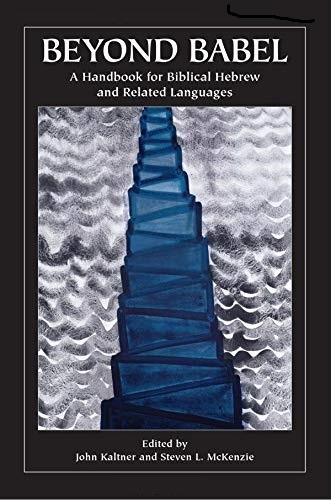
Kevin Gillette
Words Across Time
18 May 2022
wordsacrosstime
#Kevin Gillette#Words Across Time#wordsacrosstime#May 2022#Beyond Babel#John Kaltner#Steven L McKenzie#Society of Biblical Literature#Oxford Academic#Christian#Scripture#Old Testament#New Testament#Hebrew#Aramaic#Chaldean#Daniel#Ezra#Near East#Middle East#North Africa#Biblical-era#Nilo-Hamitic#Semitic Languages#Semitic#Amharic#Ethiopia#Maltese#Latin#Arabic
4 notes
·
View notes
Text
The Man Who Died
[The Man Who Died. By Antti Tuomainen. Translated by David Hackston. Orenda Books Ltd. 10 October 2017. 300 pages. Paperback. ISBN 9781910633847 (publication details thanks to Orenda Books Ltd]
I am partially Finnish – 25%, to be precise, through my mother’s side of the family. As I’ve grown older, I’ve come to cherish this part of my heritage more and more, as I realize how unusual it is relative to many other ethnicities. I do not speak Finnish, but I enjoy learning about the various idiosyncrasies of the language, the people, the culture, and the nation of Finland. The volume under review here was a gift from my sister, who knows how much I appreciate the Finnish zeitgeist.
This offering from Antti Tuomainen actually represents a departure for the author, who is known as one of the premier exponents of what’s known as Scandinavian noir fiction. The book is a murder mystery with a twist (more on that in a moment). Stylistically, one is reminded of Henning Mankell, Stieg Larsson or Peter Høeg. But Tuomainen injects considerable dark humor into his narrative, something none of the aforementioned authors broker in – their works dwell under a slate-grey sky, while this book basks at times in the Finnish summer and at times in its reflected glow.
At the heart of the story is Jaakko Kaunismaa, an entrepreneur in exotic mushrooms living in the (fictional) town of Hamina in southeastern Finland. The narrative is told in first-person style, giving us access to Jaakko’s unique insights and ruminations. Now for that twist: Jaakko is actually murdered. At the outset of the novel, he learns that he has been systematically poisoned by a person or persons unknown using a sophisticated toxin or toxins that the doctors cannot identify. The only thing the medical professionals know for sure is that Jaakko is a dead man walking. He may have days, weeks, or months to live – there is no consensus. No antidote or organ transplant can save him; he’s too far gone.
Cue the existential crisis of the lifetime (literally!) for our hero. As with the film, DOA (either the 1949 film starring Edmund O’Brien or the 1988 remake starring Dennis Quaid), this leaves the protagonist with a limited amount of time and energy to try and figure out who has murdered him and why. It could be his energetic but wayward wife Taina. It could be the principal mechanic and general dogs-body at the mushroom plant Petri. It could be his product drying expert Olli. Or it could be a new faction that has arrived on the Hamina mushroom scene in the person of three nemeses Asko, Sami and Tomi. Others figure in the absurdist tableaux as well. Jaakko’s trajectory through the story features encounters with a samurai sword, a dogged Lieutenant Columbo-style police detective named Tikkanen, shadowy Japanese clients of the exotic mushroom business, and Jaakko’s own increasingly fevered imagination. Tuomainen’s descriptive skill puts the story on cinematic footing; every misadventure and incident plays out fully in the reader’s mind. In the end it is almost irrelevant who poisoned Jaakko – justice has been rendered to a number of the principals in the drama, sometimes in the most tragicomic fashion possible.
After reading this, I am seriously tempted to look into Tuomainen’s other work, knowing full well that he is not a murder-mystery writer at heart. Just his peculiar and oblique view of life is enough to pique my interest. But even if you’re only a mystery fan, this will still be the book for you. Enjoy the ride, but strap in tight – it’s a bumpy one!

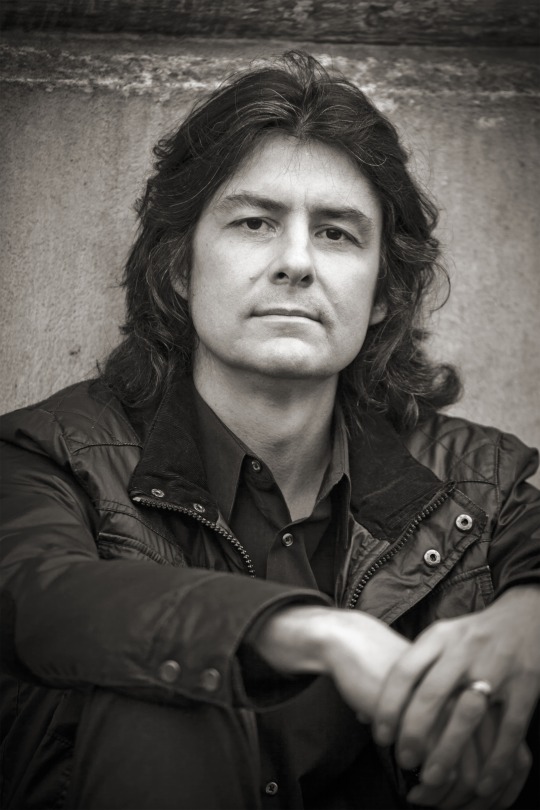
[Photo Credits: Cover Ⓒ 2017 Orenda Books Ltd / portrait Ⓒ Photo Credit: Jorgen Ringstrand - thanks to Penguin Books Australia www. penguin. com. au 29 March 2022]
Kevin Gillette
Words Across Time
29 March 2022
wordsacrosstime
#Kevin Gillette#29 March 2022#Words Across Time#wordsacrosstime#The Man Who Died#Antti Tuomainen#David Hackston#Orenda Books#10 October 2017#Finnish#Finland#Scandinavian Noir Fiction#Henning Mankell#Stieg Larsson#Peter Høeg#Edmund O’Brien#Dennis Quaid#Lieutenant Columbo#Japanese#Oblique View Of Life#Fevered Imagination#Murder Mystery#Exotic Mushrooms#Absurdist Tableaux#Cinematic Footing#Tragicomic#Tikkanen#Twist#Southeastern Finland#Jaakko Kaunismaa
3 notes
·
View notes
Text
In The Woods
[In The Woods. Tana French. 2007. Editions by publishers including Viking Books, Hodder & Stoughton, Hachette. ISBNs include 9780670038602, 9781444758344]
Thrillers are often categorized as pulp fiction, and deservedly so. While containing wonderfully exciting stories, they typically lack evidence of the skill and panache of a truly well-trained fiction writer. Not so this freshman effort from Irish author Tana French. She engages us right out of the chute with a stream-of-consciousness prologue that treats a memory sequence in perhaps the most realistic way possible, with missing pieces and non-linearity. From this launch pad the story is catapulted into present-day Ireland, specifically a suburb of Dublin.
The protagonist is Rob Ryan, a detective in the Dublin Garda’s famous Murder Squad. He and his partner-cum-best friend Cassie Maddox are sent to the picturesque shire of Knocknaree. Unbeknownst to Cassie, Rob Ryan is actually Adam Ryan, a native of Knocknaree who was involved in a tragic child-disappearance case (two of his friends) many years prior. He had been sent away to a boarding school in England during his later teen years, and so he no longer sounded like a local boy, and with the name change and the commonness of Ryan as a surname in Ireland, no one thought twice about him working on the new case.
The new case is the murder of a local teen girl. Her body is discovered on an altar stone at the center of an archaeological dig being conducted on the fringe of Knocknaree. Suspects and motives abound, between the girl’s father, the numerous archaeologists at the dig, and some of the more colorful town folk who knew the girl and her siblings. While the investigation is going on, Ryan is concerned that the girl’s murder may be connected with the incident in which he was involved all those years ago. Moreover, he is terrified of being discovered by his boss to be the same Adam Ryan from that long-ago tragedy, as this conflict of interest could signal the end of his career as a detective. As the story progresses, all of the aforementioned leitmotifs are on a collision course. Where Ms French’s skill comes most into play is in delineating the delicate balance between reason and emotion, the fragility of memory and the power and pain of truth as seen through the eyes of a fractured psyche.
This novel is a wonderful first entry into the lexicon of the Dublin Murder Squad. I will essay the other works (there are 6 in all) as I am able to finish reading them. I highly recommend this novel to anyone who enjoys Dorothy L Sayers, PD James, Elizabeth George, or Patricia Cornwell.


[Photo Credits: Cover Ⓒ 2007 Viking thanks to abebooks.com 16 March 2022 / portrait Ⓒ Jessica Ryan, thanks to tanafrench.com 16 March 2022]
Kevin Gillette
Words Across Time
16 March 2022
wordsacrosstime
#Kevin Gillette#Words Across Time#wordsacrosstime#March 2022#In The Woods#Tana French#Hodder & Stoughton#Viking#Dorothy L Sayers#P D James#Elizabeth George#Patricia Cornwell#Ireland#Dublin.#Crime Fiction#Police Procedural#Pulp Fiction#Dublin Garda#Murder Squad#Knocknaree#Archaeological Dig#Altar Stone#Human Remains#Boarding School#Rob Ryan#Cassie Maddox#Adam Ryan#Stream Of Consciousness#Child Disappearance#Murder
0 notes
Text
The Nightingale (2018 film)
[The Nightingale. Release dates - 6 September 2018 (Venice), 29 August 2019 (Australia). Running time - 136 minutes. Director / Writer Jennifer Kent. Producers - Kristina Ceyton, Steve Hutensky, Jennifer Kent, Bruna Papandrea. Starring - Aisling Franciosi, Sam Claflin, Baykali Ganambarr, Damon Herriman, Harry Greenwood, Ewen Leslie, Charlie Shotwell, Michael Sheasby. Cinematography - Radek Ladczuk. Editor - Simon Njoo. Music - Jed Kurzel. Production Companies - Causeway Films, Made Up Stories, Bron Creative, FilmNation Entertainment. Distributor - Transmission Films. Country - Australia. Languages - English, Irish, Palawa kani. (credit information thanks to Wikipedia)]
The Nightingale is an independent Australian film set in 1825 in the interior of Tasmania. It chronicles the plight of Clare, a young Irish woman who was caught stealing in England and was sent to what was then a huge penal colony for the British Empire to serve her sentence. Tasmania was known as the most brutal of the colonies in Australia, holding as it did the majority of murderers, rapists, and violent criminals who weren’t otherwise hanged or shot. For some reason, foreign nationals who were convicted of crimes got sent there too, even if their crimes were non-violent or of far lesser severity.
Clare is indentured to Lieutenant Hawkins, a nasty, sadistic and ruthlessly ambitious young officer in the Royal forces. As the film begins, Clare has been permitted to marry a fellow Irishman and even dwell in a small shack / midden heap that serves as her residence. She has a newborn baby girl as well. Clare has already served the full term of her seven-year sentence and several months besides, and she is querying Lt. Hawkins about getting her release papers. However, alas, Clare is not only beautiful (of course), but she is also a talented singer (ergo the title of the film), and is frequently trotted out by Hawkins to perform for visiting dignitaries and so on. Given his lack of humanity and his cruel streak, Hawkins seems disinclined to release her from her servitude to him. Her husband attempts to intervene on Clare’s behalf, but trouble and tragedy ensue. Lives are lost, and the lieutenant and a small entourage hastily depart the local encampment for the coastal community of Launceston where a potential captaincy appointment awaits him.
Clare, who is enraged beyond the point of reason, sets out in pursuit of Hawkins. Since she doesn’t know the interior of Tasmania, and because in 1825 British forces and the local Aboriginal population were locked in a tense genocidal battle called the Black War, Clare retains the reluctant services of Billy, an Aboriginal scout and tracker, as her guide.
Through the main course of the film, Clare and Billy have an uneasy and at times tempestuous alliance, but as they are united against a common enemy (the British forces, and in particular, Lt Hawkins), they reach a rapprochement through their trials and tribulations. Along the way, a great many unpleasant truths are hinted at regarding the Black War, surely an unsavory chapter in the history of colonialism.
This film is quite simply outstanding. The scenery, the language (in addition to English, the film features healthy doses of both Irish Gaelic and an Australian Aboriginal creole known as Palawa kani), and the desperation of all of the principal characters are extremely compelling.
A linguistic aside: Palawa kani is a constructed language (not unlike Swahili, which was developed from several Bantu/Bantoid languages as a lingua franca for trade), used by modern Aboriginal peoples in Australia as pieced together from often scant records of the languages that were spoken centuries ago. The Tasmanian Aboriginal languages in particular are extremely poorly attested; it is unclear how any of them actually sounded due to an almost complete lack of written accounts and transliterations. Recalling that Aboriginal culture and language are living and fluid, Palawa kani is one of many endeavors to capture and preserve this linguistic and cultural heritage. The film is dedicated to these people and their efforts at societal preservation. One might also note that as with many pre- and proto-literate languages, Palawa kani features a great deal of phonemic and semantic repetition. This reflects the need of the language to perpetuate itself without the benefit of a conservatizing written form (at least in the past). Repetition => memory => forward conveyance through time.



Photo credits: Film Poster [top] © 2018 production/distribution companies. Portrait of Aisling Franciosi [centre] © 18 August 2016 Mark McCaughrean. Portrait of Jennifer Kent [bottom] © 5 July 2014 Camille Griner
Kevin Gillette
Words Across Time
2 March 2022
wordsacrosstime
#Kevin Gillette#wordsacrosstime#Words Across Time#March 2022#The Nightingale#Jennifer Kent#Aisling Franciosi#Sam Claflin#Baykali Ganambarr#Damon Herriman#Harry Greenwood#Ewen Leslie#Charlie Shotwell#Michael Sheasby#Radek Ladczuk#Simon Njoo#Jed Kurzel#1825#Tasmania#British Empire#Lieutenant Hawkins#Launceston#Aboriginal#Black War#Gaelic#Palawa kani#Newborn Baby Girl#Penal Colony#Violent Criminals#Hanged
1 note
·
View note
Text
Loops, Knots, Gauge Theories and Quantum Gravity
[Loops, Knots, Gauge Theories and Quantum Gravity. Rodolfo Gambini & Jorge Pullin. 1996. Cambridge University Press. ISBN 0521654750 // Cambridge University Press website data: Rodolfo Gambini, Universidad de la República, Uruguay. Jorge Pullin, Pennsylvania State University. Foreword by Abhay Ashtekar. Online publication date: September 2009. Print publication year: 1996. Online ISBN : 9780511524431]
The world of modern theoretical physics has many factions, each adhering to what they believe to be the best abstract representation of physical reality, whether at the tiniest (sub-atomic) or the largest (cosmological) sizes. Probably the most popular one at the time of this writing is String Theory and its offshoots such as M-theory. A candidate for the strongest competing theory is that of Loop Quantum Gravity. This latter theory is espoused by numerous world-class physicists such as Lee Smolin and Carlo Rovelli. String theory models reality as comprising strings (both open- and closed-ended) that ‘vibrate’ at different frequencies and different modes, the result of which is the manifestation of all known particles that make up the Universe. Loop quantum gravity (or LQG) has as its aim the task of seamlessly marrying up quantum mechanics (which describes small particle interactions and behaviors to extraordinary accuracy, excluding gravity) and cosmology, which deals almost exclusively with gravity itself.
The disconnect occurs because the forces that underly atomic and sub-atomic interactions (strong force, weak force, and electromagnetic force) are immensely powerful compared to gravity, and theories that can describe both scales of force strength simultaneously have proved devilishly hard to construct. What is interesting is that the stronger the underlying force, the shorter the distance over which it is effective – this explains why the strong force (for example), which binds protons and neutrons together in atomic nuclei as well as binding quarks together into elementary particles called hadrons, is only effective over a distance of about 10-15 meters (about the width of a proton), but it is nevertheless approximately 1038 times as strong as gravity, which has influence that is essentially without limit (across the Universe, in fact). This is where LQG enters the picture.
Loops in this context are not the same thing as strings in string theory. Rather, loops are a mathematical vehicle for computing what is called a holonomy. Think of a loop as a circle (or a knot – see below), and imagine that there is an arrow sitting on that circle, perhaps pointing in the direction of the circle in a sort of tangent line. Now apply some sort of ‘transport’ to this arrow, propelling it around the circle while doing things to it: stretching, re-orienting, etc. When the arrow arrives back at the point where it started, what has happened to it? Is it the same length? Is it still pointing the same direction? The degree to which this arrow has been altered as a consequence of the transport around the circle is the holonomy associated with that point on the circle and the force that propelled the arrow.
Knots in physics are a useful notion because the orbit (in spacetime) of a charged particle can be described by a knot in a topological sense. To be clear: A knot is pretty much what you think it is colloquially. In mathematics, the definition of a knot is a smooth embedding of a closed loop in 3-dimensional space. This embedding maps the starting object – a circle, or what is sometimes known humorously as the un-knot – to the more involved, tangled thing that we think of intuitively as a knot.
Gauge theories (in physics) seek to identify those properties of things like the propelling action described two paragraphs back that remain unchanged under certain types of re-mapping (translations from one place to another, or rotations, for example). In the alternative, the degree to which these properties change under the re-mapping is a complementary view of gauge theories.
Gambini & Pullin have done an admirable job making this monograph a self-contained one. The first section talks about loop representations and the associated calculus for working with them. It then proceeds to apply these representations to Maxwell electrodynamic theory, and Yang-Mills theory, which attempts to marry the electromagnetic and strong forces mentioned above. They then apply these ideas to quantum gravity specifically – that is, the use of loop representations to characterize the notion that gravity itself is ‘experienced’ in discrete chunks rather than as a continuous field (although these chunks are unimaginably small!). From there, the monograph delves into more topics that deal with knot theories and a related topic called the braid algebra (this latter topic is a central concept in certain ideas of quantum computing and quantum information science as well). The monograph concludes with open areas of research, some of which have been addressed in recent years since the publication of the volume.
This book, though very well-written and fairly complete, is definitely advanced; graduate-level mathematics and physics are needed to make much sense of what’s going on. But it’s quite a ride for the stout of heart.
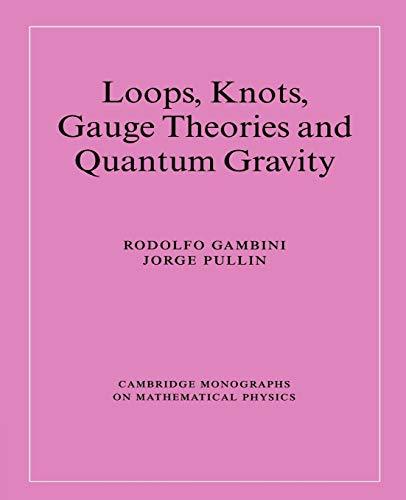
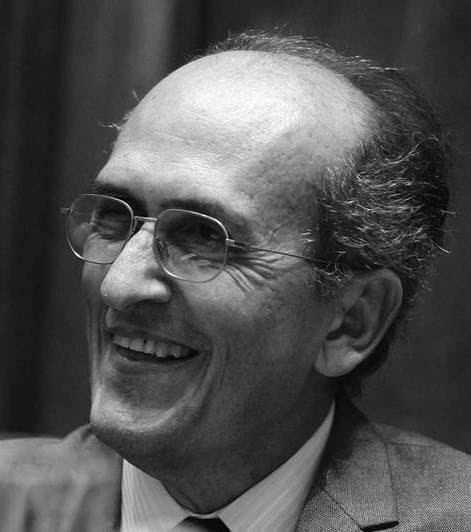

Photo credits: Cover : © 1996 Cambridge University Press. Portrait [centre] : Rodolfo Gambini © unknown. Portrait [bottom] : Jorge Pullin © unknown, from Louisiana State University website.
Kevin Gillette
Words Across Time
23 February 2022
wordsacrosstime
#Words Across Time#wordsacrosstime#23 February 2022#Rodolfo Gambini#Jorge Pullin#Abhay Ashtekar#Carlo Rovelli#Lee Smolin#Yang-Mills#Pennsylvania State University#Cambridge University Press#Universidad De La República#Knots#Loops#Gauge Theories#Quantum Gravity#Loop Quantum Gravity#Maxwell Electrodynamic Theory#LQG#String Theory#Hadrons#Braid Algebra#M-Theory#Re-Mapping#Cosmology#Holonomy#Spacetime#Quarks#Theoretical Physics#Sub-Atomic
0 notes
Text
Navier-Stokes Equations and Nonlinear Functional Analysis
[Navier-Stokes Equations and Nonlinear Functional Analysis. Roger Temam. 2nd Edition. 1 January 1987. CBMS-NSF Regional Conference Series in Applied Mathematics, Series Number 66. Publisher; Society for Industrial and Applied Mathematics. Paperback: 155 pages. ISBN-10: 0898713404. ISBN-13 9780898713404. Dimensions: 17.15 x 1.27 x 24.77 cm. Thanks to Amazon for technical publication data. First Edition 1983]
A couple of years ago my wife and I watched an utterly charming film called Gifted, starring Chris Evans and an adorable girl named McKenna Grace. The story revolved around the little girl, who was a mathematics prodigy being raised by her uncle (Evans) after her mother committed suicide some time prior. The uncle wants his niece to have the benefit of a normal childhood despite her extraordinary gift, whereas his mother (her grandmother), herself a mathematician of some renown, dearly wants to exploit the little girl’s talent, perhaps as a way of making up for the lack of a connection with the daughter she lost.
At the center of this drama is a putative proof of one of the famous Millennium Problems put forth and sponsored by The Clay Mathematics Institute. These seven problems are regarded as the most difficult ‘important’ math problems in the world. There is a cash prize of $1,000,000 to anyone who can either prove one of the assertions or provide a convincing counterexample disproving the statement. To date, only one of them has been solved, the Poincare Conjecture (now the Poincare Theorem).
The fourth stated assertion involves the Navier-Stokes (N-S) equations, which are a set of partial differential equations that describe the evolution of fluid flow in 2 and 3 dimensions. Fluid here means either a gas or a liquid, the latter generally being considered incompressible. There is a curious issue with the N-S equations in that it should be possible to state very precise yet general circumstances under which the equations admit a solution that is unique. Such a statement addresses existence and uniqueness of solutions based on initial fluid flow conditions and the shape of the domain in which the fluid flows. However, to date, such existence and uniqueness of solutions has only been definitively shown for 2 dimensions. There is something about going up to 3 dimensions that gives a bit too much wiggle room to easily show that, given arbitrary initial conditions and domain description, one can either guarantee (perhaps by direct solving) a unique solution or show that one cannot exist.
In the aforementioned film, the little girl’s dead mother apparently had written a proof of the N-S equations for 3 dimensions, and thus could have laid claim to the Clay Institute prize for solving one of the Millennium problems. The trouble is that no one seems to know where she left the proof. The film moves forward with this premise and the dramatic tensions between the desires of the girl’s uncle and the girl’s grandmother, each with their own view on how best to nurture (or exploit) the little girl’s phenomenal potential.
Back in the real world, this N-S problem continues to be an active area of research well more than a century after it was first posed. Prof Temam is a leading researcher in this area of applied and computational fluid dynamics. The monograph reviewed here is an excellent compendium of the many fundamental issues facing the scientist who wishes to work with the N-S equations in a practical setting.
Temam first essays the questions related to existence, uniqueness and regularity (solutions can’t have physically impossible whirlpools, for example) of solutions to the N-S equations. He points out the paradox between the two- and three-dimensional versions of these equations. He describes the setting and general solution framework for the equations, drawing on both classical and newer a priori results (these latter are similar to the ansatz approach to problems in physics). He then surveys some issues in functional analysis related to the analyticity of the time-evolved equations as well as more over-arching representational elements to the problem.
The second half of the monograph deals with somewhat more general functional analysis questions, most of which are directly applicable to the Navier-Stokes equations but are by no means limited to them. A brief third section deals with computational aspects of N-S equations, including such minutiae as grid size, convergence of short- and long-term solutions (and the marrying up of same), and a brief appendix that describes inertial manifolds (a functional space description in which the solutions to the N-S equations should naturally reside).
This monograph is very well-written in my opinion, and I say this as someone who has not done very much fluid dynamics work as a mathematician – I learned a great deal from it. As one might expect, the level of mathematics is graduate/post-doctoral level, and requires a strong background in measure theory, functional analysis, and topology, as well as a healthy acquaintanceship with numerical analysis, especially techniques designed for classes of partial differential equations.
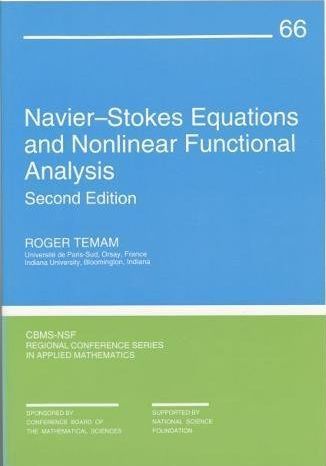

[Cover © 1987 Society for Industrial and Applied Mathematics; portrait of Roger Temam © Indiana University Bloomington, USA]
Kevin Gillette
Words Across Time
2 February 2022
wordsacrosstime
#Kevin Gillette#Words Across Time#wordsacrosstime#February 2022#Society for Industrial and Applied Mathematics#CBMS-NSF#Navier-Stokes Equations#Nonlinear Functional Analysis#Applied Mathematics#Indiana University Bloomington#Universite de Paris#Gifted#Chris Evans#McKenna Grace#Mathematics Prodigy#Clay Mathematics Institute#Millennium Problems#Poincare Conjecture#Poincare Theorem#Roger Temam#ansatz#Inertial Manifolds#Measure Theory#Functional Analysis
4 notes
·
View notes
Text
Binary
[Binary by John Lange (aka Michael Crichton). 1 January 1972. First edition. Publisher: Alfred A Knopf. Hardcover. Pages: 220. ISBN 0394479874. Publication details: thanks to Amazon]
As a kid, I was a huge fan of Michael Crichton, starting with The Andromeda Strain. I eagerly read through his entire published oeuvre. Or so I thought.
About 35 years ago, a friend mentioned that Crichton had written a number of shorter novels under a pen name, John Lange. The explanation given at the time was that he was in medical school and there was some sort of rule that med students couldn’t publish fiction under their own name – just scholarly papers. In recent days I’ve learned that this wasn’t quite the truth, but it makes for a good legend. The novel under review here is one of the last novels Michael Crichton wrote as John Lange before he finished medical school and then decided he didn’t want to be a doctor after all; he wanted to be a writer!
Binary is a thriller that follows the exploits of a government agent known as Graves who is in pursuit of a brilliant but delusional fellow named John Wright. Wright, the only child of a hugely wealthy titan of industry, is a sort of Lyndon Larouche character with all the attendant craziness of views. Graves and several U.S. agencies discover that Wright is, or at least appears to be, contemplating some sort of terrorist act during the Republican National Convention in 1972 in San Diego. [Historical note: While Crichton/Lange was finishing this novel, something caused the Republican National Committee to relocate the convention to Florida. Crichton didn’t want the spend the time completely re-framing his story in Miami, so San Diego remains enshrined in the book as the location of the convention.]
Graves knows Wright better than any living person, having followed his various activities for many years. Wright is canny, arrogant, and extremely talented at disguising his motivation and objectives. Thefts and purchases of a number of unusual and seemingly disparate items by Wright and his people create confusion and panic with Graves and his associates. Eventually they find that Wright has acquired a pair of tanks of an incredibly deadly nerve gas called ZV. The gas is quite harmless when stored as its two constituent halves – it’s when they’re combined that their lethality becomes all too evident.
Graves needs to find Wright and ascertain what he’s done with the binary mixture before it’s too late. Along the way he’ll deal with some demons of his own, as well as the knowledge that Wright appears to know him just as well as he knows Wright. Has Wright correctly predicted all of the moves Graves will make to neutralize the threat?
Binary is a genuine page-turner in the grandest sense. It’s also a fairly modest investment of time; Amazon (via their Kindle device and app) estimate that it takes less than three hours for the average reader to complete it. But it’s truly an exhilarating ride through the hearts of darkness of a madman and his pursuer.
I highly recommend this book to anyone who is a fan of Michael Crichton, especially his earlier works like The Andromeda Strain, The Terminal Man, and his screenplay of the science-fiction film, Westworld.
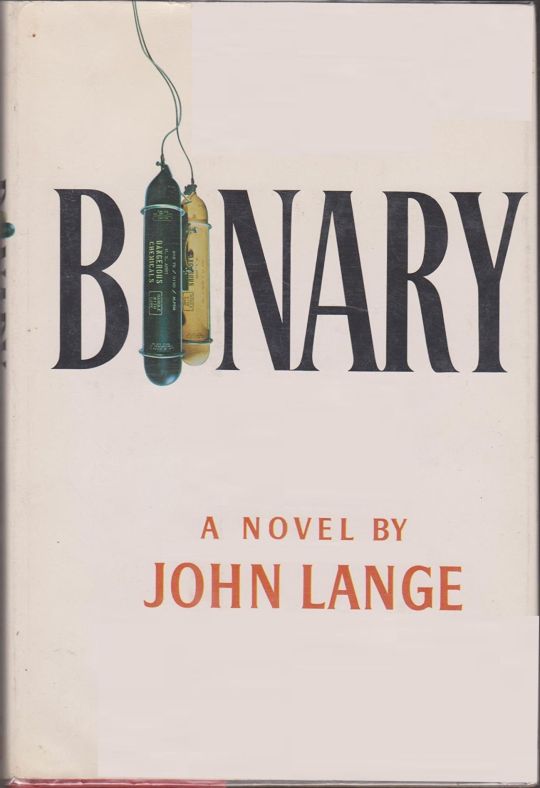

[Cover © 1972 Alfred A Knopf; portrait of John Lange aka Michael Crichton © 1977 MGM, photographer not known]
Kevin Gillette
Words Across Time
19 January 2022
wordsacrosstime
#Kevin Gillette#Words Across Time#wordsacrosstime#January 2022#John Lange#Alfred A Knopf#MGM#The Andromeda Strain#Jurassic Park#Binary#John Wright#Lyndon Larouche#Republican National Convention#San Diego#The Terminal Man#Westworld#Disclosure#Prey#State of Fear#Next#The Lost World#Pirate Latitudes#Airframe#The Great Train Robbery#Jasper Johns#Life Goes To A Party#Runaway#The 13th Warrior#Michael Crichton
0 notes